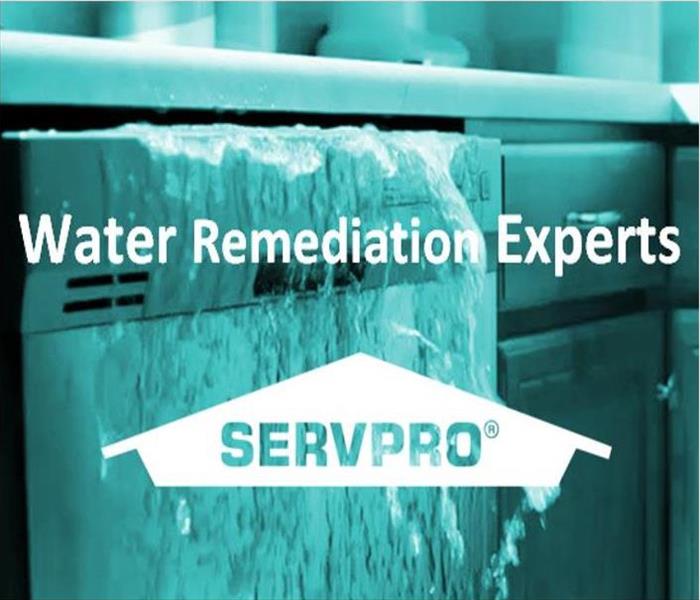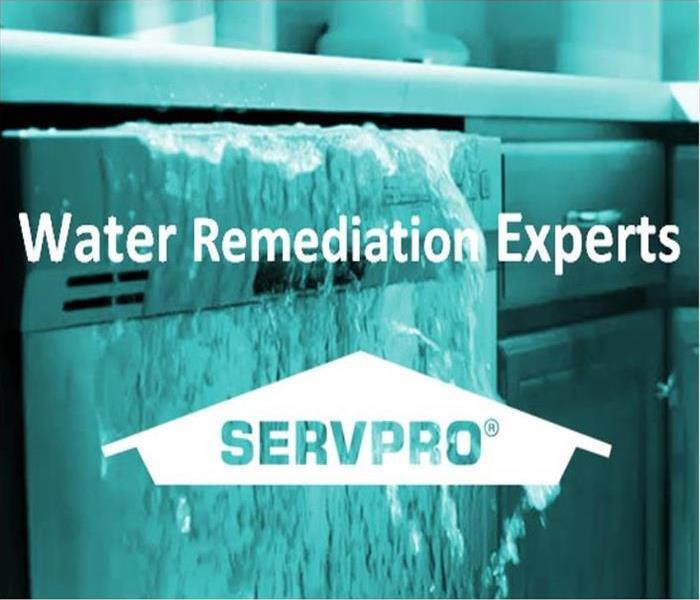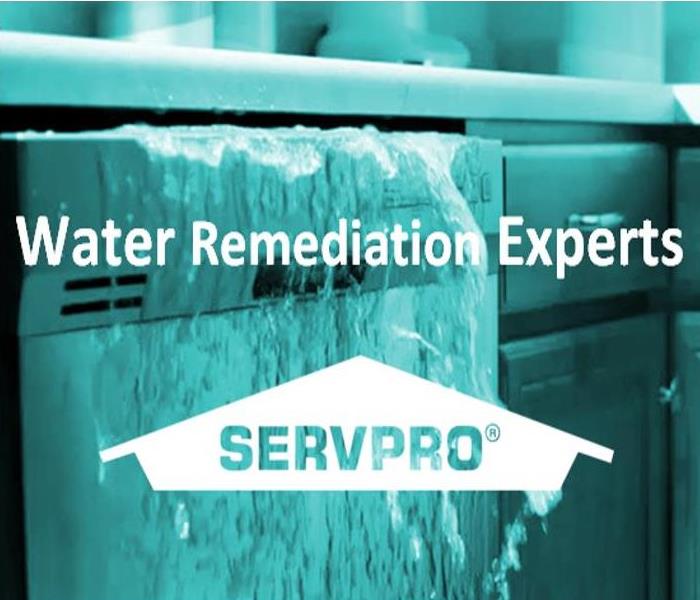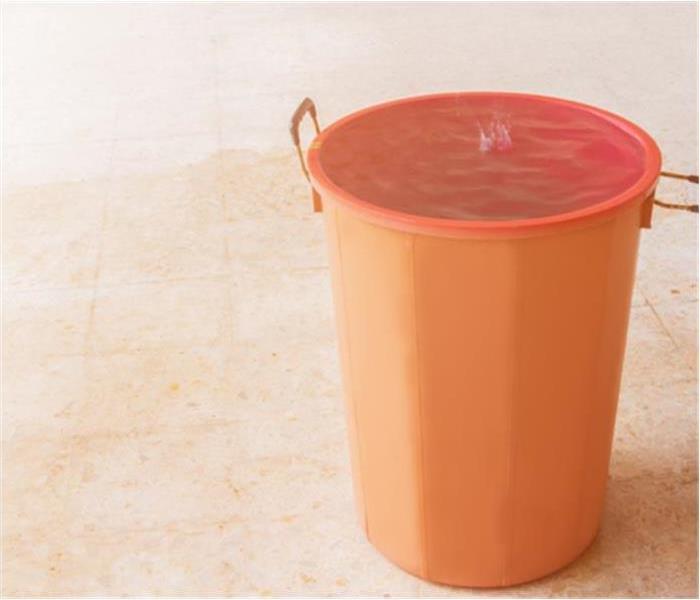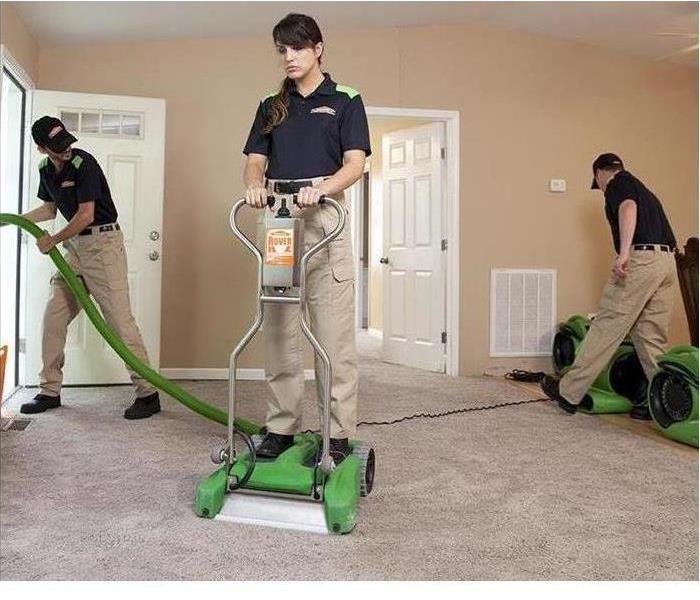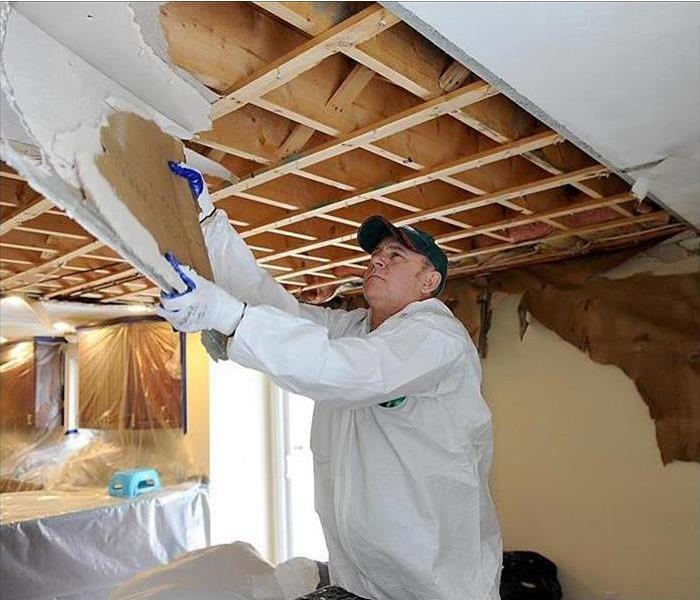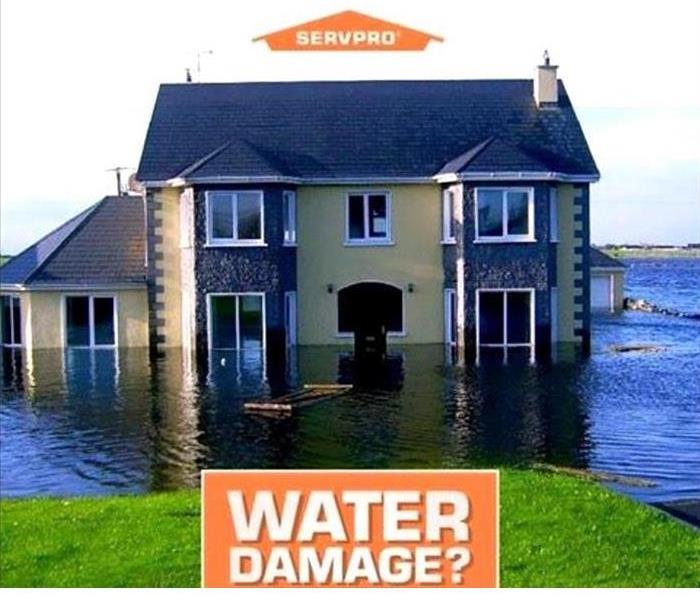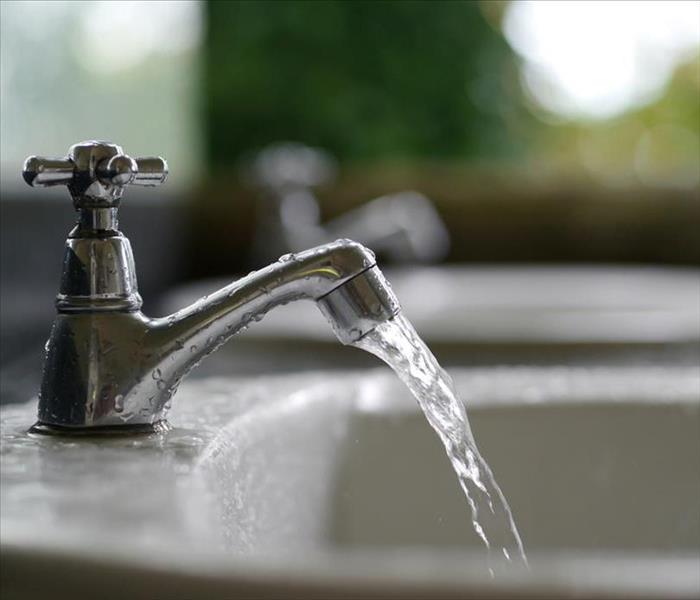Recent Water Damage Posts
Top 5 Reasons to Call Us After Water Damage
1/1/2025 (Permalink)
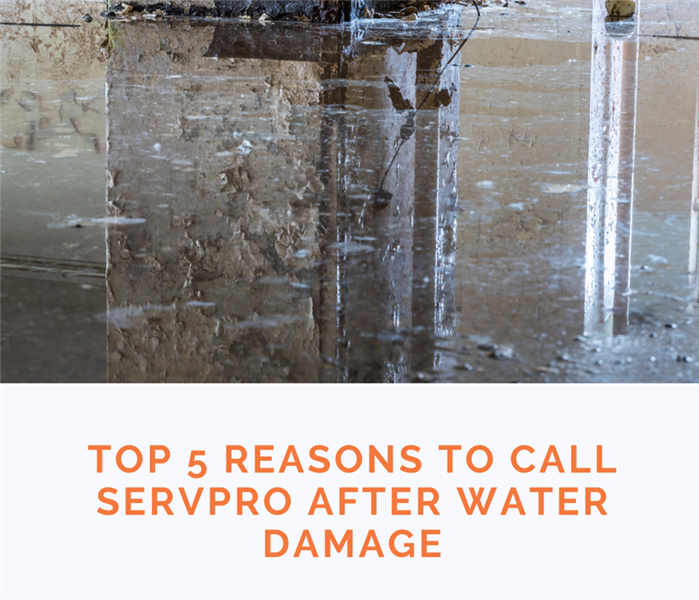 As a trusted leader in the restoration industry, SERVPRO of Newton/Wellesley is equipped with the advanced training and tools needed to restore.
As a trusted leader in the restoration industry, SERVPRO of Newton/Wellesley is equipped with the advanced training and tools needed to restore.
Water damage often strikes without warning, leaving your home or business at risk of long-term consequences if not addressed quickly. Here’s why reaching out to us after water damage is the best decision you can make:
1. Act Quickly to Prevent Mold Growth
Water damage can create the perfect environment for mold to grow within 24–48 hours. Our team responds promptly to mitigate water damage and stop mold before it takes hold.
2. Advanced Water Removal and Drying Technology
We use state-of-the-art equipment, from powerful water extractors to advanced drying systems, to ensure your property is thoroughly dried—even in hard-to-reach places like behind walls or beneath flooring. This meticulous approach helps prevent further structural damage.
3. Experienced Professionals You Can Trust
Our highly trained team has years of expertise in water damage restoration, handling everything from minor leaks to major floods. We provide safe, efficient, and customized care to restore your property with confidence.
4. Streamlined Insurance Claim Assistance
Dealing with insurance after water damage can be stressful. We work directly with insurance providers, offering detailed documentation and expert guidance to make the claims process as smooth as possible.
5. Proven Results That Speak Volumes
We’ve helped countless property owners recover from water damage. Whether it’s a homeowner whose basement was salvaged after a pipe burst or a business that reopened quickly after a flood, our success stories reflect our dedication and expertise.
Don’t let water damage take a toll on your property. As a trusted leader in the restoration industry, SERVPRO of Newton/Wellesley is equipped with the advanced training and tools needed to restore your home or business efficiently and effectively.
Frozen Pipes and Ice Dams: What to Do If You Return to Winter Water Damage
12/10/2024 (Permalink)
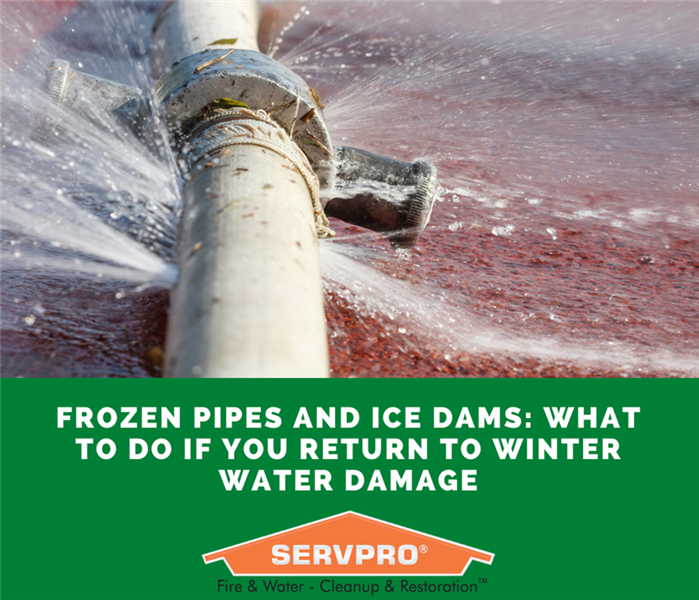 By spotting early warning signs, acting swiftly, and taking preventive measures, you can protect your home from frozen pipes and ice dam damage.
By spotting early warning signs, acting swiftly, and taking preventive measures, you can protect your home from frozen pipes and ice dam damage.
Winter vacations are the perfect time to relax, but coming home to frozen pipes or water damage can quickly undo that peace of mind. When temperatures drop, frozen pipes and ice dams can lead to leaks, water damage, and costly repairs if not addressed promptly. Here's everything you need to know to identify, resolve, and prevent these common winter hazards.
1. Understanding the Risks: Frozen Pipes and Ice Dams
- Frozen Pipes: When temperatures plunge, water inside pipes can freeze and expand, causing cracks or bursts. Once thawed, the resulting leaks can flood your home and cause extensive damage.
- Ice Dams: Ice dams form when melting snow on your roof refreezes at the edges, creating blockages. This trapped water can seep into your home, damaging walls, ceilings, and insulation.
2. Signs of Frozen Pipes or Ice Dam Damage
Be vigilant for these warning signs:
- Water Stains: Discoloration on walls or ceilings may point to leaks from melting ice dams.
- Low Water Pressure: Weak water flow could indicate frozen pipes restricting water movement.
- Pooling Water or Damp Spots: Look for unexpected moisture near exterior walls, basements, or under sinks.
- Frost on Pipes: Pipes in unheated spaces, like basements or attics, may visibly frost over if frozen.
3. Immediate Steps to Take
If you discover water damage or suspect an issue, act quickly to minimize harm:
- Shut Off Water: Turn off your home's main water supply to halt leaks from a burst pipe.
- Turn Off Power: For flooded areas, cut electricity to avoid dangerous water-electricity interactions.
- Drain Pipes: Open all faucets to release trapped water and reduce pipe pressure.
- Remove Standing Water: Use towels or a wet-dry vacuum to mop up water, especially on carpets or wood floors, to prevent mold growth.
4. Thawing Frozen Pipes Safely
For frozen but intact pipes, follow these steps:
- Apply Heat Gradually: Use a hair dryer, space heater, or heating pad to warm pipes slowly. Avoid open flames or intense heat, which can damage pipes.
- Start with Accessible Pipes: Begin with exposed pipes, then address harder-to-reach areas.
- Keep Faucets Open: A trickle of running water helps thaw pipes faster and relieves pressure.
5. Handling Ice Dam Damage
If an ice dam has caused water to infiltrate your home, take these steps:
- Inspect Insulation: Remove and replace any wet attic insulation to prevent mold growth.
- Check Walls and Ceilings: Repair damp or discolored areas quickly to avoid further damage.
- Dehumidify: Use a dehumidifier to dry out remaining moisture from walls and ceilings.
6. When to Call Professionals
Certain situations require expert help, including:
- Significant flooding or water damage.
- Mold growth on affected surfaces.
- Water infiltration into electrical systems or insulation.
Professional water restoration teams, like SERVPRO of Newton / Wellesley, use advanced tools such as industrial fans, dehumidifiers, and moisture meters to ensure a thorough cleanup.
7. Preventing Future Issues
Take these preventive measures to safeguard your home:
- Insulate Pipes: Wrap exposed pipes with foam or insulation tape.
- Leave Faucets Dripping: A small trickle of water helps prevent freezing during extreme cold.
- Enhance Attic Insulation: Proper insulation slows roof snowmelt, reducing ice dam risks.
- Clear Gutters: Remove debris from gutters to allow melting snow to drain freely.
8. Pre-Travel Precautions
Before leaving for a winter getaway, prepare your home:
- Set Your Thermostat: Keep it at least 55°F to prevent freezing.
- Shut Off Water Supply: If feasible, turn off the main water line and drain pipes.
- Open Cabinets: Allow warm air to circulate around pipes under sinks.
Winter vacations should leave you feeling refreshed, not stressed. By spotting early warning signs, acting swiftly, and taking preventive measures, you can protect your home from frozen pipes and ice dam damage.
SERVPRO of Newton / Wellesley has advanced training and equipment to restore your home or business, giving you peace of mind during winter and beyond.
How to Handle Residential Water Damage: Steps to Recovery
11/20/2024 (Permalink)
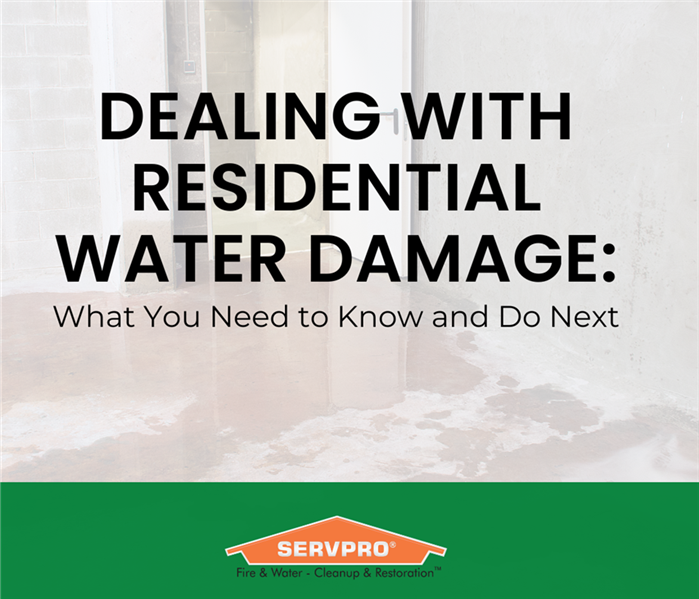 No matter the cause, water damage can lead to serious consequences, including structural issues, mold growth, and the loss of personal belongings.
No matter the cause, water damage can lead to serious consequences, including structural issues, mold growth, and the loss of personal belongings.
Water damage in your home can occur unexpectedly—whether from a burst pipe, flooding, or a roof leak.
No matter the cause, water damage can lead to serious consequences, including structural issues, mold growth, and the loss of personal belongings. Acting quickly is essential to minimizing damage and beginning restoration. Here's a step-by-step guide to help you navigate the process and understand the importance of professional restoration services.
Step 1: Stop the Water at Its Source
The first step is to locate and stop the source of water. If it’s a burst pipe, turn off your home’s main water supply. For issues like a broken water main, contact your utility provider. In cases of flooding caused by natural disasters, wait until it's safe to enter your home. Your safety should always be the top priority.
Step 2: Assess the Damage
Once it’s safe, evaluate the extent of the damage. Water can seep into walls, floors, and ceilings, often causing damage that isn’t immediately visible. Mold can start growing within 24-48 hours, so time is critical. Take photos and document the damage for your insurance claim. Depending on the severity, professional assistance may be necessary to identify hidden issues.
Step 3: Notify Your Insurance Provider
Contact your homeowner's insurance company to report the damage and begin the claims process. Provide detailed documentation, including photographs and repair estimates. Keep records of any expenses related to temporary lodging, repairs, or replacement of belongings. These costs may be covered under your policy.
Step 4: Begin Water Removal and Drying
Standing water can worsen the damage and encourage mold growth. Immediate action is crucial. Professional restoration teams use powerful pumps, vacuums, and industrial-grade fans to extract water and thoroughly dry your home.
- Carpet and Flooring: Wet carpets and rugs often need removal and drying or replacement. Wood flooring may warp and require expert treatment.
- Drywall and Insulation: Water-damaged drywall may need to be cut out and replaced to prevent mold. Wet insulation often loses its effectiveness and poses health risks, necessitating replacement.
Step 5: Address Mold Risks
Mold thrives in damp, hidden areas like behind walls and under floors. It can spread quickly, posing health risks to your family. Restoration professionals use advanced tools like moisture meters and infrared cameras to identify hidden moisture. Antimicrobial treatments are applied to prevent mold growth and ensure a safe environment.
Step 6: Restore and Repair
With the water removed and the area dried, restoration can begin. Depending on the damage, this may involve:
- Replacing drywall, flooring, and insulation
- Repairing or replacing damaged furniture and fixtures
- Restoring personal items like clothing, electronics, and documents
Professional restoration teams will guide you through the process, ensuring your home is fully repaired and safe to live in.
Step 7: Take Preventive Steps
Once your home is restored, focus on prevention to reduce the risk of future water damage:
- Regularly inspect your roof, windows, and plumbing for leaks.
- Install a sump pump if you live in a flood-prone area.
- Waterproof your basement to minimize flood risks.
Partner with Experts for Reliable Restoration
Water damage can be overwhelming, but quick action and professional help can mitigate the damage and reduce costs. From stopping the source of water to preventing mold growth, every step is critical to restoring your home.
At SERVPRO of Newton/Wellesley, we provide expert water damage restoration services with advanced equipment and training. Don’t wait—call us at (617) 332-9000 for fast, reliable assistance to help you recover quickly and safely.
How to Protect Your Home from Heavy Rainfall and Flooding in Wellesley, MA
8/12/2024 (Permalink)
 Heavy rainfall and flooding can cause significant water damage to your home, leading to costly repairs and potential health hazards.
Heavy rainfall and flooding can cause significant water damage to your home, leading to costly repairs and potential health hazards.
Heavy rainfall and flooding can cause significant water damage to your home, leading to costly repairs and potential health hazards. Preparing your home for such events involves taking proactive steps to prevent water intrusion. Here’s how you can protect your home from water damage during heavy rainfall and flooding in Wellesley, MA
Seal Cracks in Foundations
Cracks in your home's foundation are a common entry point for water. Sealing these cracks can prevent water from seeping into your basement or crawl space. Here’s how to do it:
- Inspect Your Foundation: Regularly check your foundation for cracks, especially before the rainy season.
- Use Epoxy or Polyurethane Sealant: Fill small cracks with an epoxy or polyurethane sealant. For larger cracks, consider hiring a professional to ensure a thorough repair.
- Apply Waterproof Coatings: Apply a waterproof coating to your foundation walls to add an extra layer of protection against water intrusion.
Install Sump Pumps
A sump pump is a crucial device for preventing basement flooding. It automatically pumps out water that collects in a sump basin, keeping your basement dry. Here’s what you need to know:
- Choose the Right Pump: Select a sump pump that fits your needs, considering the size of your basement and the amount of water typically encountered.
- Regular Maintenance: Test your sump pump regularly to ensure it’s functioning correctly. Clean the pump and the sump basin to prevent clogs.
- Consider a Backup System: Power outages often accompany heavy storms, so having a battery backup or water-powered backup sump pump can provide additional protection.
Use Sandbags
Sandbags are an effective way to divert water away from your home during heavy rainfall. They can be placed strategically to block water from entering vulnerable areas. Here’s how to use them:
- Stock Up on Sandbags: Keep a supply of sandbags on hand, especially if you live in a flood-prone area.
- Placement: Place sandbags around doors, windows, and other entry points to create a barrier against floodwaters.
- Layering: Stack sandbags in a staggered pattern, similar to laying bricks, to ensure a tight seal and maximum protection.
Maintain Proper Drainage
Proper drainage around your home is essential to prevent water accumulation and intrusion. Here’s how to maintain effective drainage:
- Clean Gutters and Downspouts: Regularly clean your gutters and downspouts to ensure they are free of debris and can effectively channel water away from your home.
- Extend Downspouts: Extend downspouts at least five feet away from your foundation to direct water away from your home.
- Grade Your Yard: Ensure the ground slopes away from your home to prevent water from pooling near the foundation. You may need to add soil to low areas or regrade your yard for proper drainage.
Additional Tips
- Install French Drains: French drains are underground drainage systems that help divert water away from your home. Consider installing them in areas where water tends to accumulate.
- Inspect and Maintain Plumbing: Regularly inspect your plumbing for leaks and repair any issues promptly to prevent water damage from inside your home.
- Prepare for Emergencies: Have an emergency plan in place, including knowing how to shut off your home’s water supply and having essential supplies ready in case of flooding.
By taking these preventative measures, you can significantly reduce the risk of water damage to your home during heavy rainfall and flooding. Stay vigilant and proactive, and your home will be better equipped to withstand the challenges of severe weather.
SERVPRO of Newton / Wellesley is your comprehensive solution for residential and commercial restoration and cleaning services. Our highly trained technicians are available 24/7 to address any water, fire, or storm damage in Newton, Wellesley, Needham, Waban, MA, and surrounding areas.
Preparing for Spring Storms and Floods in Chestnut Hill, MA
5/23/2024 (Permalink)
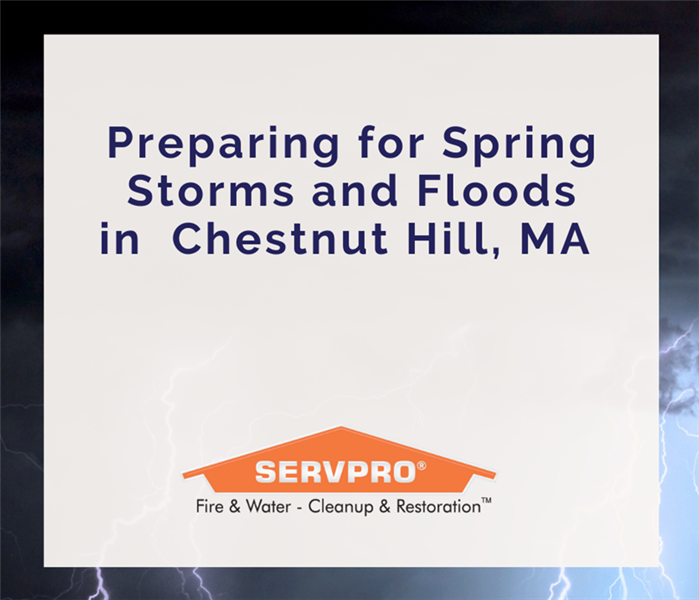 Taking these proactive measures can protect your commercial property from spring storms and floods.
Taking these proactive measures can protect your commercial property from spring storms and floods.
Spring brings renewal but also weather challenges, such as heavy rainfall, high winds, and flooding, which can threaten commercial properties in Chestnut Hill, MA. Here are tips for preparing your property:
- Inspect Your Roof: Check for damage or wear and tear. Repair or replace damaged shingles or flashing to prevent leaks during heavy rain.
- Clean Gutters and Downspouts: Ensure proper drainage by cleaning them. Clogged gutters can lead to water damage to the building's exterior and foundation.
- Check Drainage Systems: Clear debris from storm drains and culverts to prevent flooding during heavy rain.
- Trim Trees and Shrubs: Prevent damage from high winds by trimming them, also reducing the risk of roof and window damage.
- Inspect Windows and Doors: Seal gaps or cracks with weatherstripping or caulk to prevent water seepage during storms.
- Secure Outdoor Items: Prevent damage by securing outdoor furniture, signage, and other items that could become projectiles in strong winds.
- Backup Important Data: Protect data and documents from loss by backing them up in a secure off-site location or in the cloud.
- Create an Emergency Plan: Develop a plan outlining what to do in severe storms or floods, including evacuation routes, emergency contacts, and utility shut-off procedures.
- Review Insurance Coverage: Ensure adequate protection against storm and flood damage, considering adding flood insurance for flood-prone areas.
- Stay Informed: Monitor weather forecasts and alerts to stay ahead of potential storms or flooding.
Taking these proactive measures can protect your commercial property from spring storms and floods. Preparedness is key to minimizing the impact of severe weather on your property and business. SERVPRO of Newton/Wellesley is available to assist with your commercial or residential property needs.
Service Areas
Newton, MA | Wellesley, MA | Needham, MA | Waban, MA | Chestnut Hill, MA | Newton Upper Falls, MA | Newton Highlands, MA | Needham Junction, MA | Thompsonville, MA | Newton Lower Falls, MA
How to Protect Your Business from Flood Damage in Newton, MA
5/7/2024 (Permalink)
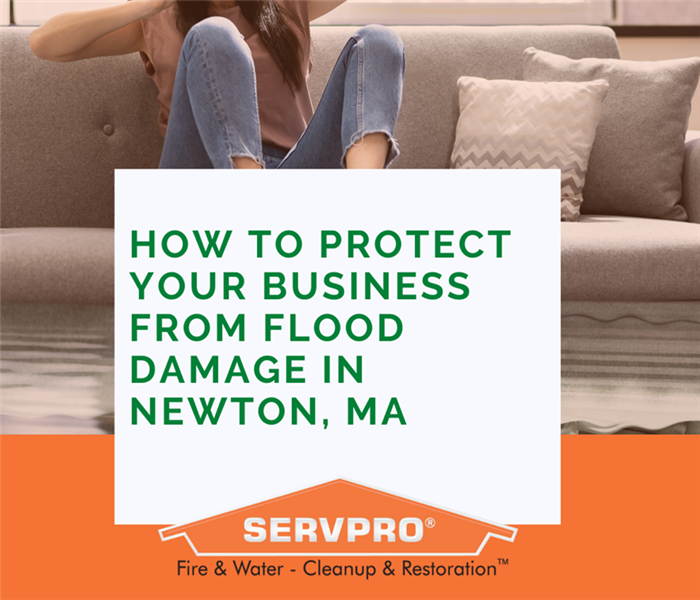 By taking these proactive measures, businesses can protect themselves from flood damage and minimize the impact of spring storms.
By taking these proactive measures, businesses can protect themselves from flood damage and minimize the impact of spring storms.
Spring brings renewal, but also challenges, especially in weather. Storms can bring heavy rain, flooding, and hazards that threaten businesses. Businesses in Newton, MA, must prepare and protect their property and operations.
- Understanding flood risk is crucial. Checking flood maps helps identify flood-prone areas. If your business is at risk, install flood barriers and seal cracks.
- Review insurance coverage, as standard commercial policies often exclude flood damage. Consider a separate flood insurance policy for adequate protection.
- Create a flood preparedness plan, including property protection, employee evacuation, and shutdown procedures. Regularly update this plan.
- Protect property by elevating equipment above potential flood levels and storing documents and data off-site or in the cloud.
- Stay informed about weather conditions. Monitor forecasts and alerts to prepare for potential flooding threats.
- Prepare an emergency kit with water, food, medications, and first aid supplies. Keep it easily accessible in case of an emergency.
- Train employees on how to respond to floods, including safe evacuation routes and shelter locations. Regularly inspect and maintain the property to identify vulnerabilities.
- Consider floodproofing measures such as flood barriers, sump pumps, and backflow valves to minimize flood impact and damage.
By taking these proactive measures, businesses can protect themselves from flood damage and minimize the impact of spring storms. SERVPRO of Newton/Wellesley is available for flood damage restoration needs.
Service Areas
Newton, MA | Wellesley, MA | Needham, MA | Waban, MA | Chestnut Hill, MA | Newton Upper Falls, MA | Newton Highlands, MA | Needham Junction, MA | Thompsonville, MA | Newton Lower Falls, MA
Preventing Water Damage in Commercial Buildings, Tips for Property Managers in Wellesley, MA
5/7/2024 (Permalink)
 SERVPRO of Newton/Wellesley is available to assist you in Wellesley, MA, with any water damage restoration needs.
SERVPRO of Newton/Wellesley is available to assist you in Wellesley, MA, with any water damage restoration needs.
Water damage can be a costly and disruptive problem for commercial buildings, leading to structural damage, mold growth, and business interruptions. As a property manager in Wellesley, MA, it's crucial to take proactive steps to prevent water damage and protect your building.
- Regular inspections are vital. Check your building's plumbing, roof, and foundation for signs of leaks, such as water stains, mold, or dampness. Maintain your roof and gutters to prevent water buildup, ensuring they are in good condition and free of leaks. Clean gutters and downspouts regularly.'
- Monitor water pressure to prevent stress on your plumbing system. Install a pressure regulator to maintain a safe level. Inspect and maintain sprinkler systems if your building has one, ensuring they function correctly and are not blocked or damaged.
- Check appliances like water heaters, dishwashers, and refrigerators for leaks or damage, replacing worn or damaged parts. Seal windows and doors properly to prevent water intrusion during storms.
- Consider installing water detection devices in leak-prone areas like basements, mechanical rooms, and bathrooms. Educate tenants about reporting leaks promptly and have a water damage response plan in place.
- Implement a regular maintenance schedule for plumbing, HVAC systems, and roofs.
Address issues promptly to prevent them from becoming larger problems. Following these tips can help prevent water damage and protect your property investment. SERVPRO of Newton/Wellesley is available to assist you in Wellesley, MA, with any water damage restoration needs.
Service Areas
Newton, MA | Wellesley, MA | Needham, MA | Waban, MA | Chestnut Hill, MA | Newton Upper Falls, MA | Newton Highlands, MA | Needham Junction, MA | Thompsonville, MA | Newton Lower Falls, MA
Handling a Flood in Your House, Steps to Take for a Swift Recovery
3/19/2024 (Permalink)
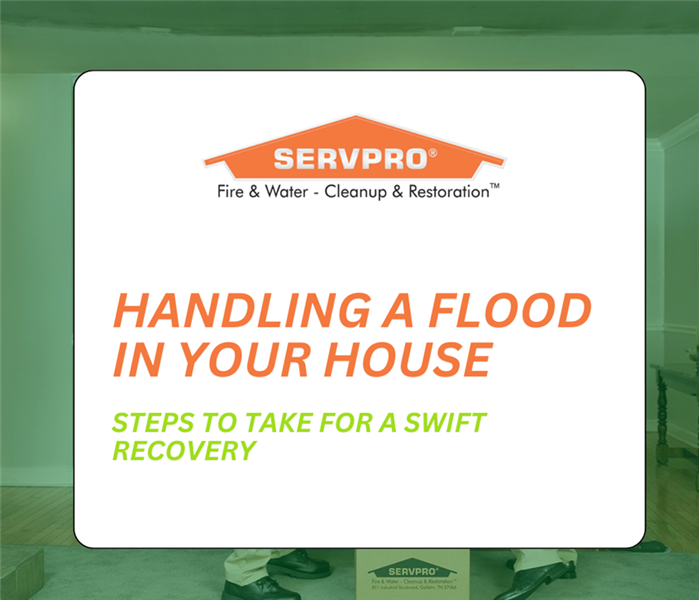 Whether it's from heavy rain, a burst pipe, or a malfunctioning appliance, a flood can cause extensive damage to your property and belongings.
Whether it's from heavy rain, a burst pipe, or a malfunctioning appliance, a flood can cause extensive damage to your property and belongings.
Experiencing a flood in your home in Wellesley, MA can be a devastating and overwhelming event. Whether it's from heavy rain, a burst pipe, or a malfunctioning appliance, a flood can cause extensive damage to your property and belongings. Knowing what steps to take in the aftermath of a flood can help you minimize damage and begin the recovery process. Here's a guide on what to do if you find yourself dealing with a flood in your house in Wellesley, MA
- Ensure Safety: Safety should be your top priority. If floodwaters are still rising and pose a risk, evacuate immediately. Avoid walking or wading through floodwater, as it may be contaminated or hiding hazards.
- Turn Off Utilities: If safe, turn off electricity, gas, and water to prevent further damage and reduce electrical hazards.
- Document the Damage: Take photos or videos of the floodwater and damage for insurance claims and restoration.
- Remove Water: Use pumps, wet/dry vacuums, or buckets to remove standing water. Lingering water can lead to mold growth and more damage.
- Dry Out the Area: Use fans, dehumidifiers, and open windows to dry the area. Mold can grow quickly, so start drying as soon as possible.
- Remove Damaged Items: Dispose of unsalvageable items like furniture, carpets, and saturated drywall. Document them for insurance first.
- Clean and Disinfect: Thoroughly clean and disinfect surfaces that contact with floodwater. Use a bleach solution to kill bacteria and mold spores.
- Contact Your Insurance Company: Notify your insurance company of the flood damage and follow their instructions for filing a claim.
- Hire a Professional Restoration Company: Consider hiring professionals for cleanup and restoration. They have the expertise and equipment for effective restoration.
- Prevent Future Floods: After cleanup, take steps to prevent future floods, like installing a sump pump or ensuring proper drainage.
Rebuilding a residential space in Wellesley, MA, after damage can be a daunting task, but with careful planning and the right team in place, it's possible to restore your property to its former glory. By following these steps, you can navigate the rebuilding process smoothly and efficiently, ensuring a successful outcome.
SERVPRO Of Newton Wellesley is The #1 Choice in Cleanup and Restoration for residential l buildings’ fire, mold, water, and storm damage. We are ready to assist your home in Newton, MA | Wellesley, MA | Needham, MA | Waban, MA | Chestnut Hill, MA | Newton Upper Falls, MA | Newton Highlands, MA | Needham Junction, MA | Thompsonville, MA | Newton Lower Falls, MA
Drowning in Damage in Newton Wellesley? Trust Our Water Restoration Experts to Save the Day
2/6/2024 (Permalink)
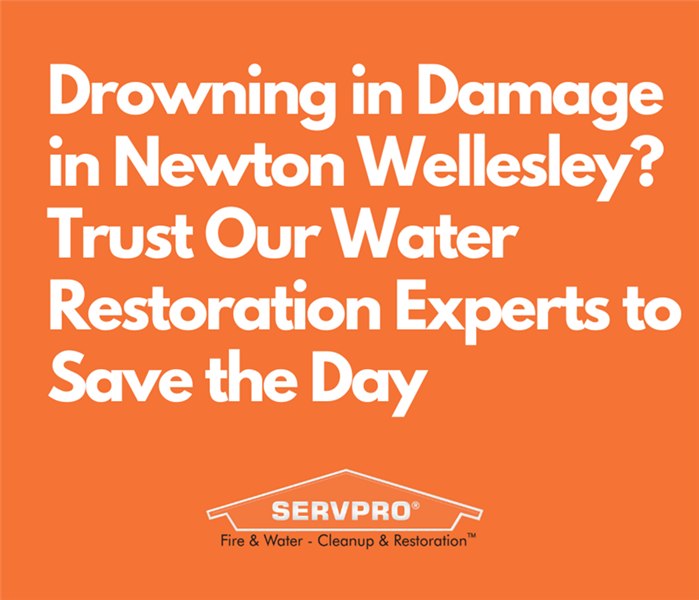 Water damage may seem insurmountable, but with a proficient team of water restoration experts, recovery is not only possible but efficient.
Water damage may seem insurmountable, but with a proficient team of water restoration experts, recovery is not only possible but efficient.
Water damage has a knack for striking unexpectedly, leaving homes and businesses in disarray. Whether it's from a burst pipe, flooding, or a leaky roof, the aftermath of water damage can feel overwhelming. In such times, having a dependable team of water restoration experts is crucial to salvaging your property and restoring it to its former state. Let's delve into the significance of professional water restoration services and why entrusting experts to handle the situation is paramount.
- Swift Response for Damage Mitigation: Time is of the essence when water damage occurs. Professional water restoration experts grasp the urgency and respond promptly to mitigate further damage. Their swift actions can prevent mold growth, structural issues, and other long-term consequences by swiftly removing excess water and moisture.
- Thorough Assessment and Customized Planning: Water damage restoration isn't a one-size-fits-all endeavor. Each case requires a meticulous assessment of the damage's extent. Experts meticulously examine affected areas, identify potential hazards, and devise a tailored restoration plan to ensure effective resolution of every aspect of the damage.
- Utilization of Advanced Equipment and Techniques: Equipped with cutting-edge tools and techniques, professional water restoration teams efficiently handle water damage. Industrial-strength water extractors, dehumidifiers, and drying equipment expedite the drying process, minimizing the risk of secondary damage.
- Expert Mold Remediation: Mold growth is a significant risk associated with water damage, often starting within 24-48 hours in damp environments. Water restoration experts possess the knowledge and experience to identify and eliminate mold, guaranteeing a safe and healthy living or working environment.
- Efficient Insurance Coordination: Dealing with insurance companies can be daunting. Water restoration professionals, experienced in liaising with insurance providers, assist in documenting damage, providing accurate assessments, and facilitating a smoother claims process.
- Comprehensive Restoration Services: Professional restoration services extend beyond water extraction and drying, encompassing structural repairs, restoring damaged belongings, and ensuring overall property safety and functionality. This holistic approach leaves no aspect of the restoration process overlooked.
- Peace of Mind for Property Owners: Facing water damage can be emotionally and mentally taxing. Hiring water restoration experts provides peace of mind, knowing that trained professionals are adeptly handling the situation, allowing property owners to focus on rebuilding and moving forward.
Water damage may seem insurmountable, but with a proficient team of water restoration experts, recovery is not only possible but efficient. Entrusting professionals to manage the restoration process ensures a thorough and effective response, providing the best chance to salvage your property and overcome the damage. When submerged in distress, don't hesitate to call upon the expertise of water restoration professionals to save the day in Newton Wellesley.
SERVPRO Of Newton Wellesley stands as the premier choice in Cleanup and Restoration for residential and commercial buildings affected by fire, mold, water, and storm damage.
Commercial Water Damage Restoration Specialists in Newton Wellesley
12/5/2023 (Permalink)
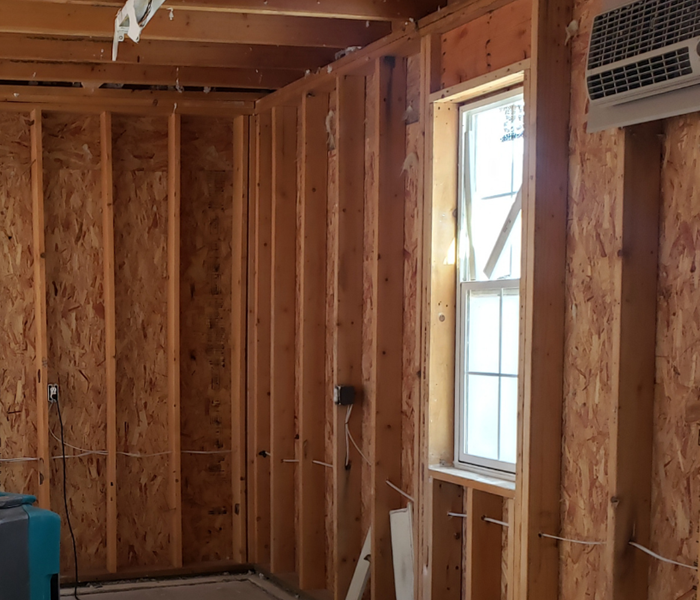 Commercial water damage restoration specialists navigate the chaos left in the wake of water-related disasters
Commercial water damage restoration specialists navigate the chaos left in the wake of water-related disasters
Water damage poses a silent threat capable of wreaking havoc on commercial properties, not only causing physical destruction but also inflicting financial and operational setbacks. In times of disaster, commercial water damage restoration specialists emerge as unsung heroes, diligently working behind the scenes to restore normalcy. Let's delve into the crucial role these specialists play and why their expertise is indispensable in the aftermath of water-related emergencies in Newton Wellesley.
The Stealthy Peril: Water damage is a pervasive challenge stemming from various sources, such as burst pipes, flooding, leaks, or natural disasters. Commercial properties, in particular, face heightened vulnerability, as the repercussions of water damage extend beyond visible destruction. Mold growth, structural compromise, and damage to valuable assets can result in significant financial losses if not promptly and effectively addressed.
The Role of Commercial Water Damage Restoration Specialists:
- Swift Response and Assessment: Recognizing the urgency in mitigating water-related disasters, commercial water damage restoration specialists respond promptly to assess the extent of the damage and formulate an effective restoration plan. Timely action can prevent secondary damage and minimize the overall impact on the property.
- Advanced Equipment and Techniques: Armed with state-of-the-art tools and technology, these specialists efficiently extract water, dehumidify affected areas, and restore the property to its pre-damage condition. Utilizing powerful water pumps and industrial-grade dehumidifiers, they expedite the restoration process.
- Meticulous Restoration Planning: Acknowledging the uniqueness of each water damage scenario, commercial water damage restoration specialists meticulously assess the situation, identifying the best course of action for each specific case. This planning encompasses considerations for structural integrity, potential mold growth, and salvaging valuable assets.
- Expertise in Mold Remediation: Following water damage, the risk of mold growth is a major concern. Commercial water damage restoration specialists are well-versed in mold remediation techniques, ensuring thorough cleaning and treatment of affected areas to prevent future infestations. This expertise is crucial for maintaining a safe and healthy working environment.
- Coordination with Stakeholders: Effective communication and coordination with property owners, insurance providers, and other stakeholders are integral to the restoration process. Serving as liaisons, commercial water damage restoration specialists provide transparent updates, ensuring all involved parties are informed about progress and next steps.
Commercial water damage restoration specialists navigate the chaos left in the wake of water-related disasters. Their expertise, coupled with advanced equipment and a commitment to swift, efficient restoration, plays a pivotal role in minimizing the impact on businesses and communities. By recognizing and appreciating the indispensable work of these specialists, we gain a better understanding of the value they bring and the significance of their role in safeguarding commercial properties from the silent menace of water damage in Newton Wellesley.
SERVPRO Of Newton Wellesley is The #1 Choice in Cleanup and Restoration for residential and commercial buildings’ fire damage.
Sump Pump Failure and the Importance of Preparedness
11/10/2023 (Permalink)
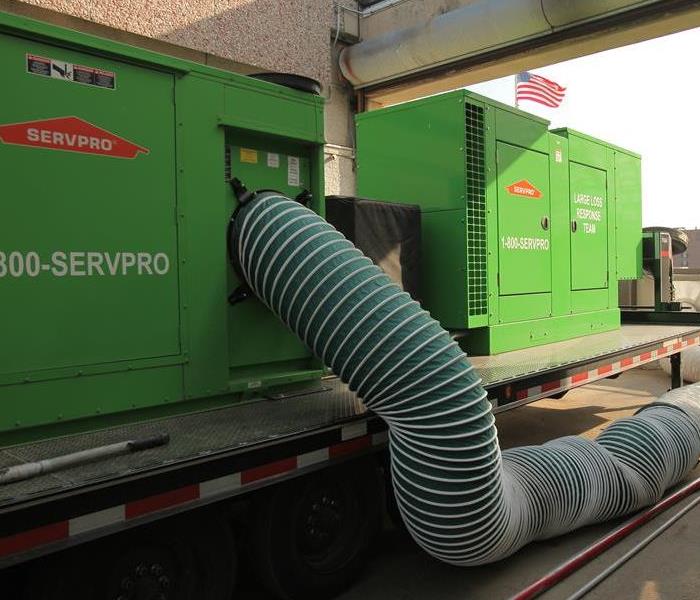 Sump pump failure poses an often underestimated yet substantial threat to the safety and integrity of your home.
Sump pump failure poses an often underestimated yet substantial threat to the safety and integrity of your home.
Uncover the reasons behind sump pump failures
In the realm of home maintenance and protection, a hidden hero lurks in basements and crawl spaces—the sump pump. While quietly executing its duty to shield homes from potential water damage, its failure can unleash disastrous consequences. Uncover the reasons behind sump pump failures, recognize warning signs, and implement essential measures to fortify your home's protection.
The Unassuming Defender:
The unpretentious sump pump plays a critical role in averting basement flooding. Nestled in a specially designed pit, it senses rising water levels and redirects excess water away from your home's foundation. This straightforward yet effective system serves as a homeowner's initial defense against water damage triggered by heavy rainfall, melting snow, or elevated groundwater.
Common Causes of Sump Pump Failure:
- Power Outages: Deprived of electricity, the pump remains inoperable, leaving your basement susceptible to flooding.
- Lack of Maintenance: Like any mechanical system, regular upkeep is essential for sump pumps. Accumulation of debris and sediment over time can impede the pump's efficiency.
- Float Switch Issues: Responsible for triggering the pump when water levels rise, the float switch can encounter mechanical failures or obstructions, impeding proper functionality.
- Frozen Discharge Pipe: In colder climates, a frozen discharge pipe can prevent the pump from expelling water, leading to potential backflow into the basement.
- Pump Overwhelm: Amidst heavy rainfall or rapid snowmelt, the sump pump may be inundated, working harder and risking failure.
Recognizing the Signs: To prevent surprise sump pump failures, stay alert for warning signs such as unusual noises—grinding or clanking may indicate mechanical issues within the pump.
Visible Rust or Corrosion: Rust or corrosion on the pump or its components signals wear and tear, potentially resulting in failure.
Frequent Cycling: An unusually frequent on-off cycle may indicate issues with the float switch or other components.
Foul Odors: Unpleasant smells suggest stagnant water in the sump pit, a consequence of the pump failing to effectively remove water.
Implement routine maintenance to clear debris, test the float switch, and verify the correct functioning of all components. Additionally, install a battery backup system to keep your sump pump operational during power outages.
Sump pump failure poses an often underestimated yet substantial threat to the safety and integrity of your home. By comprehending common causes, identifying warning signs, and taking proactive steps, you can diminish the risk of basement flooding and safeguard your property from the potential fallout of sump pump failure.
SERVPRO of Newton / Wellesley is The #1 Choice in Cleanup and Restoration for residential and commercial buildings’ mold damage. Call us today at (508) 533-5305.
How Does Water Damage Start in Newton Wellesley?
10/27/2023 (Permalink)
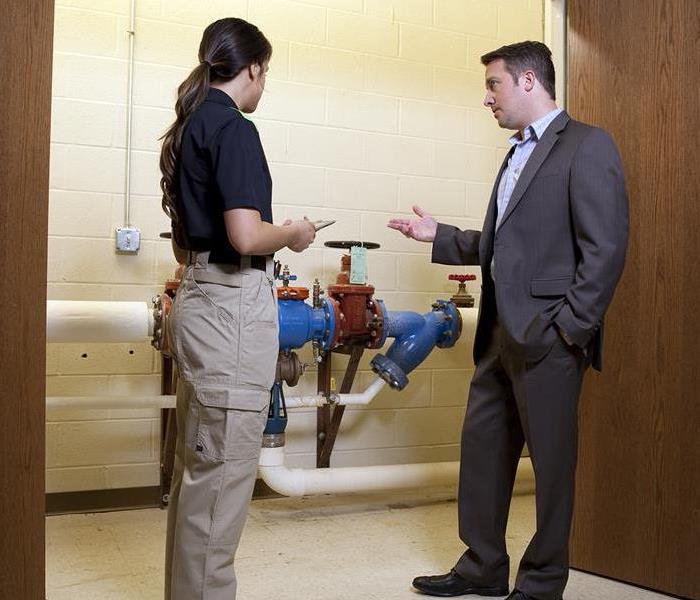 How Does Water Damage Start in Newton Wellesley? Water doesn't stand a chance against SERVPRO Of Newton Wellesley services.
How Does Water Damage Start in Newton Wellesley? Water doesn't stand a chance against SERVPRO Of Newton Wellesley services.
Water damage is a common and often underestimated threat that can wreak havoc on our living spaces. Understanding how water damage starts is crucial for prevention and timely intervention. Here are various ways water damage can initiate and explore the ripple effect it can have on our homes.
- Leaky Roofs and Damaged Shingles: Leaky roofs, often caused by damaged or missing shingles, allow water to seep into the attic and other structural components of the house. Over time, this infiltration can lead to rotting wood, weakened ceilings, and eventually, water stains on interior walls.
- Faulty Plumbing: Leaky pipes, burst hoses, and faulty plumbing fixtures are notorious for initiating water damage. A small, unnoticed leak can quickly escalate, causing damage to walls, flooring, and even the foundation of the house. Regular inspections and prompt repairs are essential to mitigate the risks associated with plumbing-related water damage.
- Clogged Gutters and Downspouts: Gutters and downspouts play a crucial role in directing rainwater away from the house. When they become clogged with debris such as leaves, twigs, and dirt, water can overflow and saturate the exterior walls. This can lead to structural damage, mold growth, and erosion around the foundation.
- Poorly Sealed Windows and Doors: Inadequately sealed windows and doors provide an entry point for water, especially during heavy rain or storms. Over time, water infiltration can lead to rotting frames, damaged drywall, and compromised structural integrity. Regularly inspecting and resealing these entry points can help prevent water damage.
- Basement Flooding: Basements are particularly vulnerable to water damage due to their location below ground level. Heavy rainfall, poor drainage, or a high water table can result in basement flooding. This can cause extensive damage to walls, flooring, and valuable possessions stored in the basement.
- Appliance Leaks: Household appliances, such as washing machines, dishwashers, and water heaters, can be sources of water damage if they develop leaks. A malfunctioning appliance or a worn-out hose can release water into the surrounding areas, leading to damage to floors, walls, and nearby possessions.
Water damage is a pervasive and potentially devastating issue that can start in various ways. Recognizing the signs and addressing the root causes promptly is essential for preventing extensive and costly damage. Regular maintenance, timely repairs, and a proactive approach to potential water entry points can safeguard your home from the silent threat of water damage. By understanding how water damage starts, we empower ourselves to protect our homes and ensure a dry and secure living environment for years to come.
Water doesn't stand a chance against SERVPRO Of Newton Wellesley commercial and residential remediation services. We're not just another remediation company; we're your partners in ensuring a safe, healthy environment. So, if you're facing a water problem, don't hesitate. You can reach a member of our team 24/7/365.
Preventing Ice Dams: A Guide to Protecting Your Home in Newton Wellesley
10/18/2023 (Permalink)
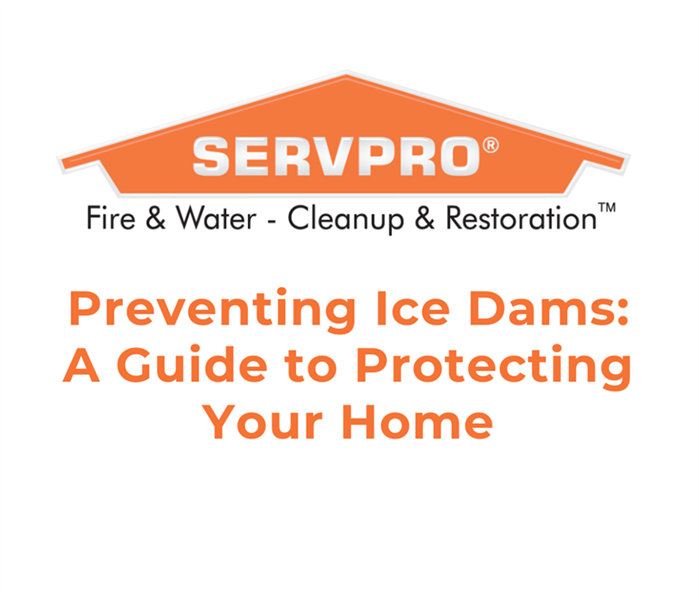 One of the most common and potentially damaging issues during the winter months is the formation of ice dams on your roof.
One of the most common and potentially damaging issues during the winter months is the formation of ice dams on your roof.
Winter can be a magical time of year, but it also brings its fair share of challenges, especially for homeowners in Newton Wellesley, MA.
One of the most common and potentially damaging issues during the winter months is the formation of ice dams on your roof. You can prevent ice dams from forming and protect your home. Learn what ice dams are, why they occur, and most importantly, how to prevent them.
Understanding Ice Dams
Ice dams are ridge-like accumulations of ice that form at the edge of your roof. They prevent melting snow and ice from draining off your roof, leading to water backing up and potentially seeping into your home. The process typically unfolds as follows:
- Snow Accumulation: A layer of snow blankets your roof.
- Heat Loss: Heat from your home escapes through the roof, causing the snow on the upper section to melt.
- Freezing Point: As the melted water reaches the lower, colder portion of the roof (usually near the eaves), it refreezes, forming a dam of ice.
- Water Backup: More snow continues to melt and flow toward the ice dam, eventually creating a pool of water that can find its way into your home through gaps in your roof or siding.
Why Preventing Ice Dams is Crucial
Ice dams can wreak havoc on your home in several ways:
- Roof Damage: The weight of ice dams can damage your roof's structure and shingles, leading to costly repairs.
- Water Damage: As the ice dams trap water on your roof, it can find its way into your home through ceilings, walls, and insulation, causing extensive interior damage.
- Mold and Mildew: Moisture infiltration can foster the growth of mold and mildew, which can pose health risks to your family.
- Energy Loss: Ice dams often form as a result of heat escaping from your home. This means you're losing valuable energy and driving up your heating bills.
Preventing Ice Dams: Tips and Techniques
Now that you understand the potential risks, let's explore some practical steps to prevent ice dams:
- Proper Insulation: Ensure your attic is well-insulated to prevent heat from escaping through the roof. Adequate insulation will keep the roof temperature uniform, reducing the chances of ice dam formation.
- Ventilation: Install roof and soffit vents to allow cool air to circulate through the attic. This helps maintain a consistent roof temperature, preventing snowmelt.
- Seal Gaps and Leaks: Seal any gaps, cracks, or openings in your roof, walls, and attic to minimize warm air leakage.
- Attic Air Sealing: Air sealing your attic can prevent warm air from escaping into the attic space.
- Roof Raking: After a heavy snowfall, use a roof rake to remove excess snow from the lower sections of your roof. This reduces the amount of snow available for melting and ice dam formation.
- Ice Dam Membranes: Consider installing an ice and water shield membrane under your roofing material, especially near the eaves, to prevent water infiltration.
- Gutter Maintenance: Keep your gutters clean and free of debris, allowing for proper water drainage. Consider installing heated gutter cables to prevent ice buildup.
- Professional Inspection: Schedule regular inspections with a roofing professional to identify and address potential issues before they become major problems.
Ice dams are a common winter woe for homeowners, but they are not insurmountable. By taking proactive steps to insulate your home, improve ventilation, and practice regular maintenance, you can significantly reduce the risk of ice dam formation. Preventing ice dams not only preserves your home's structural integrity but also keeps your energy bills in check and ensures a cozy, dry winter season indoors. Remember, a little prevention now can save you a lot of trouble and expense down the road. Stay warm, stay dry, and enjoy the winter season to the fullest in Newton Upper Falls, MA!
SERVPRO® Of Newton Wellesley is The #1 Choice in Cleanup and Restoration for residential and commercial buildings’ fire, mold, water, and storm damage. Call us today at (617) 332-9000
Dealing with Water Damage: A Comprehensive Guide
9/25/2023 (Permalink)
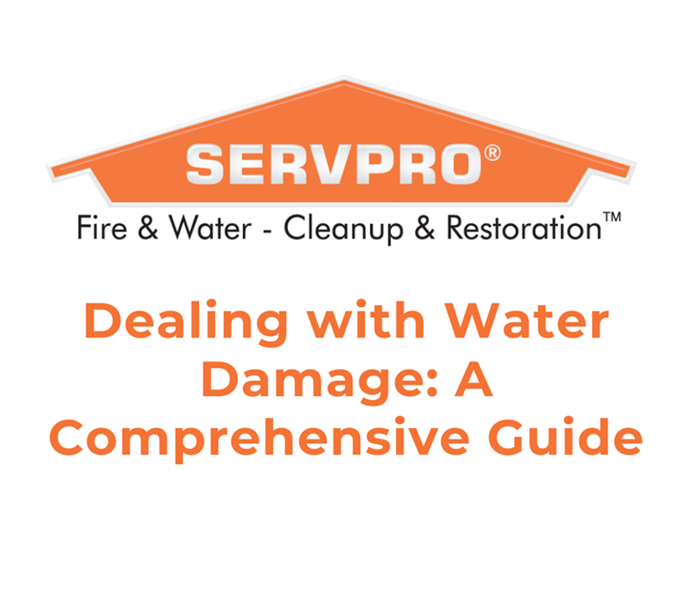 Dealing with water damage can be stressful, but following these steps and acting quickly, you can minimize the damage and ensure a smoother recovery
Dealing with water damage can be stressful, but following these steps and acting quickly, you can minimize the damage and ensure a smoother recovery
Water damage can be a homeowner's worst nightmare. Whether it's from a burst pipe, a leaky roof, a flood, or any other source, the aftermath of water damage can be overwhelming. But fear not! With the right knowledge and quick action, you can minimize the damage and ensure a smoother recovery process. Here are the essential steps to take when faced with water damage.
Ensure Safety First: Before you start dealing with water damage, prioritize safety. Turn off the power to the affected area to avoid electrical hazards. If necessary, wear protective gear such as rubber gloves and waterproof boots to prevent contact with contaminated water.
Identify the Source and Stop It: Determine the source of the water and take immediate steps to stop it. If it's a burst pipe, turn off the water supply to that area or the entire house. For roof leaks, place buckets or tarps to divert water away from the damaged area temporarily. If the water source is external (like a flood), wait for authorities to confirm it's safe before returning.
Document the Damage: Take photographs or videos of the water damage before you begin cleanup or contact your insurance company. Proper documentation can help support your insurance claim.
Call Your Insurance Company: Contact your homeowner's insurance provider as soon as possible to report the water damage. Provide them with all the necessary information, including photos and videos, so they can initiate the claims process. Be sure to ask about the specific coverage and deductible for water damage in your policy.
Remove Water and Moisture: The longer water sits, the more damage it can cause. Begin the drying process immediately by removing excess water using pumps, wet/dry vacuums, or towels. Open windows and doors to encourage ventilation and help speed up the drying process.
Salvage Valuables: Remove valuable and sentimental items from the affected area to prevent further damage. Furniture, electronics, and personal belongings should be relocated to a dry and safe place. If items are already waterlogged, consult with professionals on restoration possibilities.
Prevent Mold Growth: Mold can start growing within 24 to 48 hours after water damage occurs. To prevent mold growth, thoroughly dry and disinfect the affected area. Use fans and dehumidifiers to reduce humidity levels, and consider using mold-resistant products during repairs.
Assess Structural Damage: Check for any structural damage that may have occurred due to the water. This includes inspecting walls, ceilings, floors, and the foundation. If you suspect structural issues, consult with a professional contractor or engineer.
Repair and Restore: Once the affected area is completely dry, you can start the repair and restoration process. Depending on the extent of the damage, you may need to replace drywall, insulation, flooring, or other structural components. Work with reputable contractors or restoration specialists to ensure quality repairs.
Prevent Future Water Damage: After the cleanup and restoration are complete, take steps to prevent future water damage. Regularly inspect your home for leaks, maintain your plumbing system, and consider installing a sump pump or backflow preventer if you're in a flood-prone area.
Dealing with water damage can be stressful, but by following these steps and acting quickly, you can minimize the damage and ensure a smoother recovery process. Remember that safety should always be your top priority, and seeking professional help when needed can make a significant difference in the outcome. With proper precautions and a well-executed plan, you can restore your home to its former glory and safeguard it against future water damage.
SERVPRO Of Newton Wellesley is The #1 Choice in Cleanup and Restoration for residential and commercial buildings’ fire, mold, water, and storm damage. If you are looking for assistance, just click on the contact us page, and someone will be in touch shortly.
3 Top Causes of Fall Water in Newton Wellesley, MA Damage
8/6/2023 (Permalink)
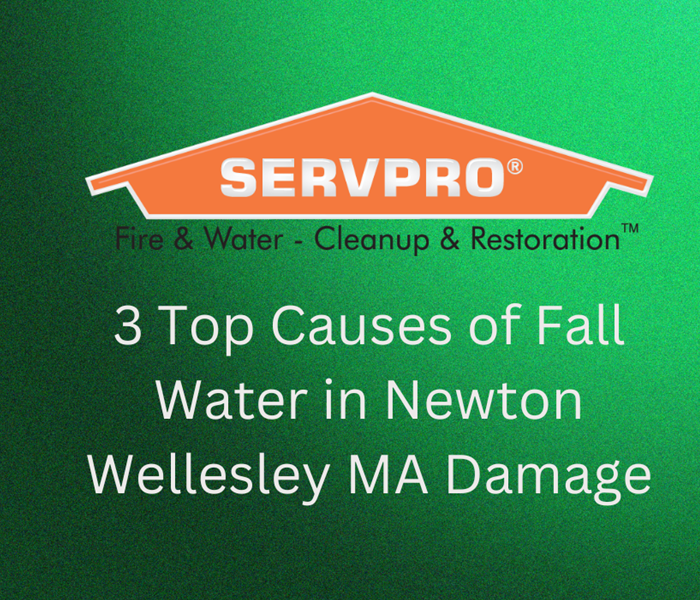 When it comes to cleanup and restoration services for residential and commercial buildings SERVPRO of Newton Wellesley is the number one choice
When it comes to cleanup and restoration services for residential and commercial buildings SERVPRO of Newton Wellesley is the number one choice
Amidst the beauty of the fall season lies potential hazards that can wreak havoc on our homes: fall water damage. The fall season poses unique challenges for homeowners, with rainfall, fallen leaves, and temperature fluctuations leading to various sources of water damage. Here are the three top causes of fall water damage and how to prevent them.
One of the primary culprits of fall water damage is clogged gutters and downspouts. The abundance of falling leaves, twigs, and debris during autumn can easily accumulate in gutters and downspouts, obstructing the proper flow of rainwater. When gutters are clogged, rainwater cannot be efficiently directed away from the roof and foundation of the house, causing potential leaks and water seepage.
Prevention Tips:
- Regularly clean gutters and downspouts, especially during the fall season. Consider using gutter guards to prevent debris buildup.
- Trim trees near your house to minimize the number of leaves falling onto the roof and gutters.
- Check for any signs of damage to the gutters and downspouts, and promptly repair or replace any compromised sections.
- Water Seepage through Cracks and Gaps
- As temperatures fluctuate during fall, any cracks or gaps in the exterior of your home can become potential entry points for water.
- Inspect the exterior of your home thoroughly, paying close attention to vulnerable areas like the roof, siding, and foundation. Seal any visible cracks and gaps with appropriate weatherproofing materials.
- Ensure that the seals around windows and doors are intact. Replace any damaged weatherstripping or caulking to prevent water infiltration.
- Maintain proper ventilation in attics and crawl spaces to regulate temperature and humidity, reducing the risk of moisture-related damage.
While fall brings with it a sense of comfort and coziness, it's essential to remain vigilant about potential water damage to our homes. Clogged gutters and downspouts, water seepage through cracks and gaps, and a leaking roof are three common culprits that can wreak havoc during this season.
When it comes to cleanup and restoration services for residential and commercial buildings' fire, mold, water, and storm damage, SERVPRO of Newton Wellesley is the undeniable number one choice. Our services extend to various areas, including Needham Junction, Needham, Newton Highlands, Newton Lower Falls, Newton Upper Falls, Thompsonville, Waban, and Wellesley, MA. Rest assured, we are here to serve and bring your property back to its former glory.
Restoring Brilliance: A Comprehensive Guide to Rebuilding After Water Damage
7/7/2023 (Permalink)
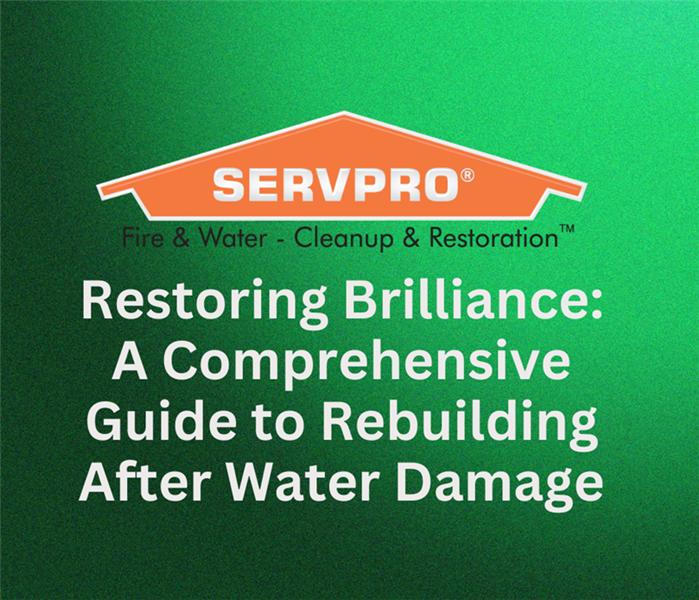 A step-by-step guide that outlines how to rebuild a building after water damage, ensuring a safe, efficient, and visually appealing transformation.
A step-by-step guide that outlines how to rebuild a building after water damage, ensuring a safe, efficient, and visually appealing transformation.
Rebuilding a building after water damage can have devastating consequences, affecting its structural integrity, functionality, and aesthetics. Whether it's caused by floods, burst pipes, or leaks, taking immediate action and careful planning are essential for successful restoration. Below is a step-by-step guide that outlines how to rebuild a building after water damage, ensuring a safe, efficient, and visually appealing transformation.
Step 1: Evaluate the Damage: Before starting the rebuilding process, it is crucial to conduct a thorough evaluation of the water damage. Engage the services of a professional inspector or a reputable restoration company to assess the extent of structural, electrical, and mold-related damage. This evaluation will provide the necessary insights for effective restoration planning.
Step 2: Prioritize Safety: Safety should always be the primary concern when working on a water-damaged building. Before entering the premises, ensure that the electrical power is shut off to prevent potential hazards. Take necessary precautions to avoid slips, falls, and exposure to contaminated water. Use appropriate personal protective equipment (PPE) such as gloves, masks, and boots.
Step 3: Water Extraction and Drying: Removing water is a critical step in the restoration process. Utilize industrial-grade pumps, wet vacuums, and dehumidifiers to extract standing water from the affected areas. Promote proper air circulation by opening windows, using fans, and employing specialized drying equipment. Eliminating excess moisture is essential to prevent mold growth and further damage to the structure.
Step 4: Mold Remediation: Moisture-laden environments are conducive to mold growth. If mold is detected, consult with experienced professionals in mold remediation. They will assess the extent of mold contamination, perform thorough cleaning, and ensure proper ventilation to prevent future mold outbreaks. Acting promptly will safeguard the health of occupants and maintain the building's integrity.
Step 5: Structural Repairs: Once the affected areas are dry and mold-free, it's time to address structural damage. Hire qualified contractors or construction professionals to repair weakened walls, floors, ceilings, and the foundation. Reinforce compromised structures, replace damaged materials, and ensure compliance with building codes and regulations. Conduct necessary plumbing repairs and inspections to prevent future water-related issues.
Step 6: Electrical and HVAC Systems: Water damage can significantly impact electrical and HVAC systems, posing potential safety hazards. Engage licensed electricians and HVAC technicians to thoroughly inspect, repair, or replace damaged components. Ensure that all systems meet safety standards and regulations before reconnecting utilities.
Step 7: Interior Restoration: The rebuilding process also involves restoring the interior spaces to their former glory. Assess and replace damaged insulation, drywall, flooring, and fixtures. Repaint walls, applying mold-resistant coatings where necessary. Consider using waterproof materials for added protection. Consult interior designers or decorators to reimagine and create functional, aesthetically pleasing spaces.
Step 8: Prevention and Preparedness: To mitigate the risk of future water damage, implement preventive measures. Install water detection systems, reinforce waterproofing measures, and regularly inspect plumbing and roof systems. Educate occupants on proactive steps to prevent water-related accidents and encourage immediate reporting of leaks or other issues.
Rebuilding a building after water damage requires careful planning, meticulous execution, and collaboration among various professionals. By following this comprehensive guide, you can navigate the restoration process confidently, ensuring the safety, functionality, and beauty of the rebuilt structure.
SERVPRO Of Newton Wellesley is the leading choice in cleanup and restoration for residential and commercial buildings affected by fire, mold, water, and storm damage. They provide their services in Needham Junction, Needham, Newton Highlands, Newton Lower Falls, Newton Upper Falls, Thompsonville, Waban, and Wellesley, MA.
How to prepare for a rainstorm
4/26/2023 (Permalink)
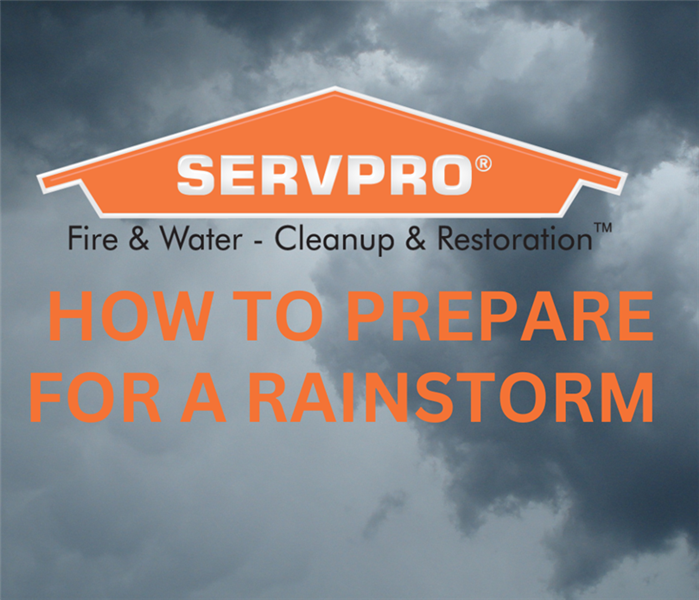 Preparing for a rainstorm is essential for minimizing damage and staying safe.
Preparing for a rainstorm is essential for minimizing damage and staying safe.
Rainstorms can come on suddenly and unexpectedly, and it's important to be prepared. Whether you live in an area prone to heavy rain or you're planning a trip during the rainy season, preparing for a rainstorm can help keep you safe and dry.
- Check the weather forecast: Before you head out, make sure to check the weather forecast. This will help you determine if a rainstorm is likely and when it is expected to arrive. You can plan your activities accordingly and be prepared for any changes in the weather.
- Make a plan: If you live in an area prone to heavy rain, it's important to have a plan in case of a rainstorm. This includes knowing where to go if you need to evacuate and having an emergency kit with essentials such as food, water, and a first aid kit.
- Protect your home: To protect your home from rain damage, make sure that your gutters are clear of debris and that your roof is in good condition. This will prevent water from seeping into your home and causing damage. You may also want to invest in sandbags to prevent flooding in low-lying areas.
- Pack accordingly: If you're planning a trip during the rainy season, make sure to pack accordingly. Bring rain gear such as a waterproof jacket and boots, as well as an umbrella. You may also want to pack a change of clothes and waterproof bags to keep your belongings dry.
- Secure loose items: Before a rainstorm arrives, make sure to secure any loose items outside, such as patio furniture or outdoor toys. This will prevent them from being blown away by the wind or causing damage during the storm.
- Stay indoors: During a rainstorm, it's best to stay indoors if possible. Avoid driving unless it is necessary, as rain can make roads slippery and reduce visibility. If you do need to go outside, make sure to wear appropriate rain gear and stay away from downed power lines or standing water.
- Stay informed: Finally, stay informed during a rainstorm. Listen to local news and weather reports for updates and alerts. Be aware of any potential dangers, such as flooding or landslides, and take appropriate action to stay safe.
Preparing for a rainstorm is essential for minimizing damage and staying safe. By following these tips and being prepared, you can ensure that you and your loved ones are ready for whatever the weather brings.
We service Needham Junction, Needham, Newton Highlands, Newton Lower Falls, Newton Upper Falls, Thompsonville, Waban, and Wellesley, MA
SERVPRO Of Newton Wellesley is The #1 Choice in Cleanup and Restoration for residential and commercial buildings’ fire, mold, water, and storm damage.
What happens if I don’t fix the water damage?
4/19/2023 (Permalink)
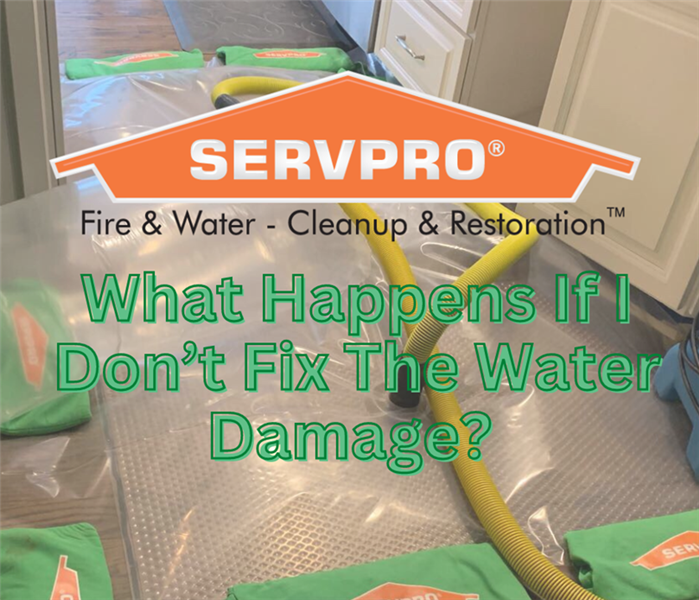 It is important to seek professional help to repair and restore your home to its pre-damaged condition.
It is important to seek professional help to repair and restore your home to its pre-damaged condition.
Water damage can be caused by a variety of factors such as leaky pipes, flooding, or a damaged roof. If not addressed promptly, water damage can cause significant problems for your home and your health. Here are some of the consequences of not fixing water damage:
- Structural damage: Water can weaken the structural integrity of your home, causing warping, cracking, and even collapse of your floors, walls, and ceilings.
- Mold growth: Water damage creates a perfect environment for mold to grow, which can lead to serious health problems such as respiratory issues and allergies.
- Electrical hazards: Water can cause electrical wiring to malfunction or even short circuit, which can cause fires and pose a serious risk to your safety.
- Odor: Water damage can cause unpleasant odors to develop, which can be difficult to eliminate without professional remediation.
- Pest infestations: Water damage can attract pests such as rodents and insects, which can thrive in damp environments and cause further damage to your home.
- Decreased property value: If left unprepared, water damage can decrease the value of your home and make it difficult to sell in the future.
- Health hazards: Water damage can create a breeding ground for bacteria and viruses, which can pose a serious health risk to you and your family.
It is important to seek professional help to repair and restore your home to its pre-damaged condition. By addressing water damage promptly, you can avoid more extensive and expensive repairs down the line and ensure the safety and well-being of your family.
We service Needham Junction, Needham, Newton Highlands, Newton Lower Falls, Newton Upper Falls, Thompsonville, Waban, and Wellesley, MA
SERVPRO Of Newton Wellesley is The #1 Choice in Cleanup and Restoration for residential and commercial buildings’ fire, mold, water, and storm damage.
How long does it take for water damage to be fixed?
3/20/2023 (Permalink)
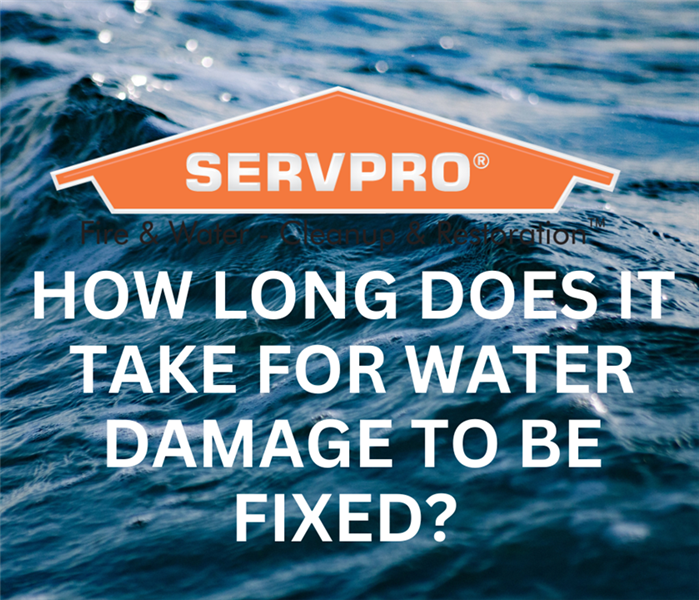 The amount of time it takes to complete each stage depends on the extent of the damage.
The amount of time it takes to complete each stage depends on the extent of the damage.
Water damage is a common problem that many homeowners face. It can be caused by a variety of factors such as leaks, flooding, and burst pipes.
In minor cases, such as a small leak, the damage can be fixed within a few hours or a day. However, for more severe cases such as a flooded basement, it can take several days or even weeks to fix the damage.
- The first step in fixing water damage is to identify the source of the water and stop it from causing further damage. This may involve shutting off the main water supply or fixing a broken pipe. Once the source of the water has been identified and fixed, the water damage restoration process can begin. The restoration process typically involves several stages, including water extraction, drying, and repair.
- Drying is the next stage, and it involves removing any remaining moisture from the affected area. This can be done using dehumidifiers and fans. The duration of this stage depends on the extent of the water damage and the humidity levels in the affected area.
- Once the area has been dried, repairs can begin. This may involve replacing drywall, flooring, and other materials that were damaged by the water. The duration of this stage depends on the extent of the damage and the materials that need to be replaced.
If you experience water damage, it is best to contact a professional restoration company to ensure that the damage is fixed properly and efficiently.
We service Needham Junction, Needham, Newton Highlands, Newton Lower Falls, Newton Upper Falls, Thompsonville, Waban, and Wellesley, MA
SERVPRO Of Newton Wellesley is The #1 Choice in Cleanup and Restoration for residential and commercial buildings’ fire, mold, water, and storm damage.
What are the steps for water damage in Newton Wellesley MA?
3/5/2023 (Permalink)
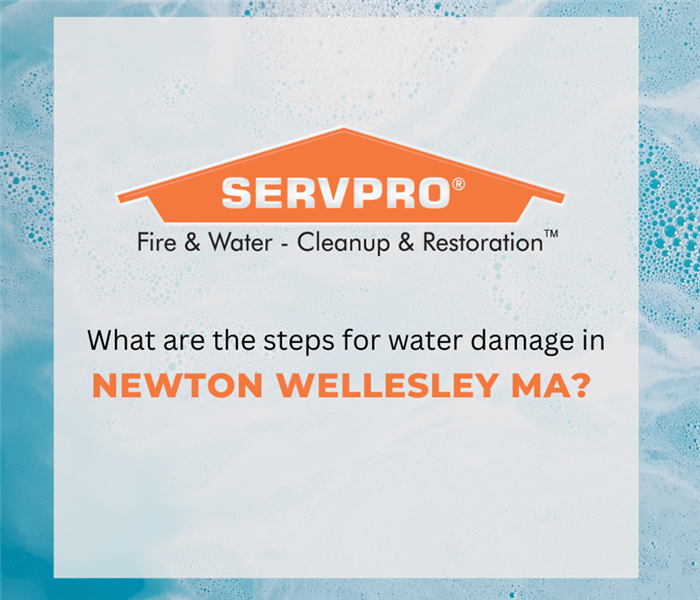 If the damage is extensive, it's best to hire a professional restoration company to ensure your home is restored to its pre-damaged condition.
If the damage is extensive, it's best to hire a professional restoration company to ensure your home is restored to its pre-damaged condition.
Water damage can be one of the most destructive problems a homeowner can face. Whether it's due to a burst pipe, a leaking roof, or flooding, water damage can cause extensive damage to your home, furniture, and personal belongings. However, taking the right steps as soon as you discover water damage can minimize the damage and save you money in the long run.
Ensure your safety: The first step in dealing with water damage is to ensure your safety. If the water damage is severe, turn off the electricity, gas, and water supply to your home before entering the affected area.
Document the damage: Before you start cleaning up the water, it's essential to document the damage for insurance purposes. Take pictures and videos of the damage to your home, furniture, and personal belongings.
Remove standing water: The next step is to remove any standing water as quickly as possible. You can use a wet/dry vacuum to remove the water or hire a professional restoration company to do the job for you.
Dry out the affected area: After removing the standing water, the next step is to dry out the affected area. You can use fans and dehumidifiers to speed up the drying process.
Clean and disinfect: Once the affected area is completely dry, it's essential to clean and disinfect the area to prevent mold growth. You can use a bleach solution to disinfect the affected area or hire a professional cleaning company to do the job for you.
Repair and restore: The final step is to repair and restore any damage. This may include replacing drywall, flooring, or furniture. It's essential to address any damage as soon as possible to prevent further problems down the road.
If the damage is extensive, it's best to hire a professional restoration company to ensure your home is restored to its pre-damaged condition.
We service Needham Junction, Needham, Newton Highlands, Newton Lower Falls, Newton Upper Falls, Thompsonville, Waban, and Wellesley, MA
SERVPRO Of Newton Wellesley is The #1 Choice in Cleanup and Restoration for residential and commercial buildings’ fire, mold, water, and storm damage.
What Causes Flooding in homes and buildings?
2/15/2023 (Permalink)
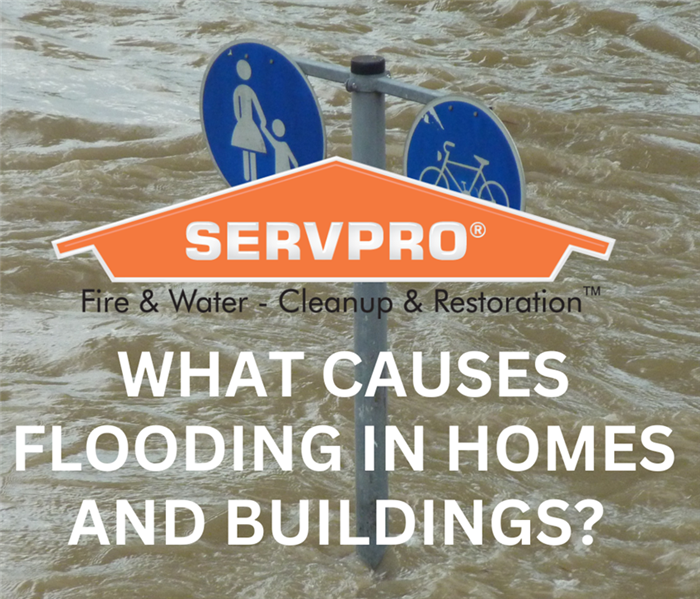 Flooding is a natural disaster that can have significant impacts on communities and economies.
Flooding is a natural disaster that can have significant impacts on communities and economies.
Flooding is a natural disaster that occurs when an area is overwhelmed by water, either from heavy rainfall or rising bodies of water. It can cause significant damage to infrastructure, homes, businesses, and agricultural land, and can be devastating to those affected. In this blog post, we will discuss the causes and impacts of flooding, as well as some measures that can be taken to mitigate its effects.
Causes of Flooding
Flooding can be caused by a variety of factors, including natural events and human activities. The most common natural cause of the flooding is heavy rainfall, particularly during prolonged periods of wet weather. This can lead to rivers and streams overflowing their banks, and low-lying areas becoming flooded.
Flooding can also be caused by rising sea levels, as well as coastal storms and hurricanes. These events can cause significant damage to coastal communities, particularly those in low-lying areas.
Human activities can also contribute to flooding. For example, the construction of buildings and other infrastructure can alter the natural flow of water, leading to increased flooding. Deforestation and other land use changes can also contribute to flooding, as they reduce the ability of soil to absorb water.
Impacts of Flooding
Flooding can have significant impacts on individuals, communities, and economies. The most immediate impact is damage to homes, businesses, and infrastructure, such as roads and bridges. This can result in the displacement of residents, loss of livelihoods, and disruption of essential services.
Flooding can also have long-term impacts on the environment. For example, it can lead to soil erosion, which can reduce the fertility of agricultural land. It can also lead to water pollution, as floodwaters can carry contaminants into rivers and other bodies of water.
Finally, flooding can have significant economic impacts. In addition to the direct costs of repairing damage to infrastructure and homes, flooding can also disrupt supply chains and reduce economic activity in affected areas.
Measures to Mitigate the Effects of Flooding
There are a number of measures that can be taken to mitigate the effects of flooding. One approach is to implement natural solutions, such as restoring wetlands and other natural features that help to absorb and slow down floodwaters. This can help to reduce the impact of flooding on communities and the environment.
Another approach is to implement engineered solutions, such as building flood protection infrastructure like levees, flood walls, and stormwater management systems. These measures can help to prevent flooding in the first place, or to reduce the impact of flooding when it does occur.
Finally, it is important to ensure that communities are prepared for flooding. This can involve measures such as developing early warning systems, establishing emergency shelters, and educating residents on how to prepare for and respond to flooding events.
Flooding is a natural disaster that can have significant impacts on communities and economies.
SERVPRO of Newton Wellesley is your premier choice for fire damage and restoration. Our teams are ready to respond 24 hours a week, any day of the year. When you bring us on the job our team of licensed contractors and certified technicians will work collaboratively with you throughout the duration of the project. They will keep you updated on the project's status and ensure that your expectations are met. We will help you to move forward and make it “Like it never even happened” for all of your fire damage.
SERVPRO of Newton Wellesley Discusses How To Prevent Flooding in a Basement
2/5/2023 (Permalink)
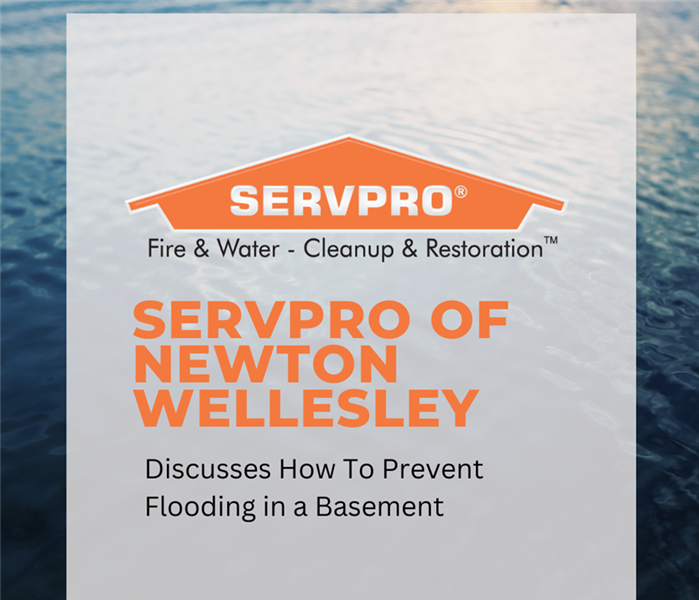 Basement flooding can be a stressful and devastating experience, but by taking the steps to prevent it and knowing what to do if it occurs, you can mi
Basement flooding can be a stressful and devastating experience, but by taking the steps to prevent it and knowing what to do if it occurs, you can mi
Flooding in a basement can be a stressful and devastating experience. It can cause extensive damage to your property and belongings, and if not addressed promptly, it can also lead to mold growth. We will discuss the causes of basement flooding, the steps you can take to prevent it, and what to do if your basement is flooded.
There are many reasons why a basement can flood. Some common causes include:
- Heavy rainfall: When there is an excessive amount of rainfall in a short period of time, it can cause water to seep into the basement through cracks in the foundation, windows, or doorways.
- Overflowing gutters and downspouts: If your gutters and downspouts are clogged, water will overflow and can seep into the basement.
- Sewer backup: A sewer backup occurs when wastewater from the sewer system enters your basement. This can be caused by a blockage in the sewer line, heavy rainfall, or a malfunction in the sewage system.
- High water table: If the water table is high in your area, it can cause water to seep into the basement through the walls or floor.
To prevent basement flooding, there are several steps you can take:
- Install a sump pump: A sump pump is a device that pumps water out of the basement when it reaches a certain level.
- Check your gutters and downspouts regularly: Make sure they are clear of debris and are directing water away from the foundation of your home.
- Install backflow valves: Backflow valves prevent sewer water from flowing back into your home.
- Seal cracks in the foundation: If you find cracks in the foundation of your home, have them sealed to prevent water from seeping in.
If your basement is flooded, it's important to take immediate action to prevent further damage and to mitigate any health risks:
- Turn off the electricity: If water has entered your basement, turn off the electricity to prevent electrical shock.
- Remove water: If the water level is not too high, use a pump or wet vacuum to remove the water. If the water level is too high, call a professional to remove the water.
- Clean and dry everything: Once the water has been removed, clean and dry all the items in the basement. This includes walls, floors, furniture, and other belongings.
- Call in professionals: If the damage is extensive, it's best to call in a professional to assess the damage and make any necessary repairs.
Basement flooding can be a stressful and devastating experience, but by taking the steps to prevent it and knowing what to do if it occurs, you can minimize the damage.
SERVPRO of Newton Wellesley is your premier choice for fire damage and restoration. Our teams are ready to respond 24 hours a week, any day of the year. When you bring us on the job our team of licensed contractors and certified technicians will work collaboratively with you throughout the duration of the project. They will keep you updated on the project's status and ensure that your expectations are met. We will help you to move forward and make it “Like it never even happened” for all of your fire damage.
SERVPRO of Newton Wellesley Shares Causes of a Flooded Basement.
1/7/2023 (Permalink)
 Proper home maintenance can prevent water problems and help save you in the future. Make sure to check rain gutters and remove all debris.
Proper home maintenance can prevent water problems and help save you in the future. Make sure to check rain gutters and remove all debris.
A flooded basement can occur anytime, especially from weather related events such as heavy rainfall or rapid snowmelt to older homes.
Below are other causes of basement flooding:
- Foundation cracks
- Broken basement windows
- Poor-draining window wells
- Sewer system problems
- Sump pump problems
- Improperly sealed basement walls
- House located at the bottom of a slope
- Weeping tile blockage
- Overflowing rain gutters
- Overflowing toilet or bathtub
- Drainage system failure
- Water heater failure
Proper home maintenance can prevent water problems and could help save you in future. Make sure to check rain gutters and remove all debris, and seal cracks in your foundation.
SERVPRO of Newton Wellesley is your premier choice for water damage and restoration. Our teams are ready to respond 24 hours a week, any day of the year. When you bring us on the job our team of licensed contractors and certified technicians will work collaboratively with you throughout the duration of the project. They will keep you updated on the project's status and ensure that your expectations are met. We will help you to move forward and make it “Like it never even happened” for all of your water damage.
SERVPRO of Newton Wellesley Shares Frozen Pipe Information
12/4/2022 (Permalink)
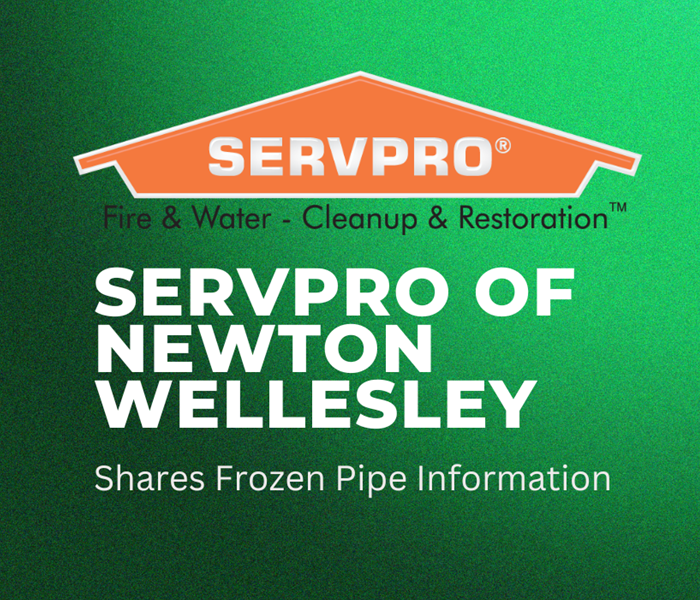 Here is what you should do if you suspect you have frozen pipes.
Here is what you should do if you suspect you have frozen pipes.
Winter months calls for frozen pipes. It is important to know and understand what this means to prevent damage to your building.
Pipes will eventually unfreeze on their own naturally. However, this takes time and could actually cause more damage because it could eventually lead to the pipe bursting.
Here is what you should do if you suspect you have frozen pipes.
- Check with a neighbor to see if they’re experiencing frozen pipes too. If they have running water, it’s likely your pipes have frozen.
- Turn off the water immediately using the main shut off valve.
- Open the faucet for water to flow through the pipe once the area is melted.
- Apply heat around the pipe using a hair dryer. Keep all heat sources away from flammable materials.
- Once pipes are thawed, you can turn the water back on and check all joints for leaks.
- Check all pipes and joints for leaks or cracks.
If there are still issues, do not wait to address them, and contact an experienced water restoration company.
If you are unsure about frozen pipes, make sure to call for assistance. We are open 24/7 and are happy to assist.
SERVPRO of Newton Wellesley is your premier choice for water damage and restoration. Our teams are ready to respond 24 hours a week, any day of the year. When you bring us on the job our team of licensed contractors and certified technicians will work collaboratively with you throughout the duration of the project. They will keep you updated on the project's status and ensure that your expectations are met. We will help you to move forward and make it “Like it never even happened” for all of your water damage.
SERVPRO of Newton Wellesley Explains Water Damage
6/5/2022 (Permalink)
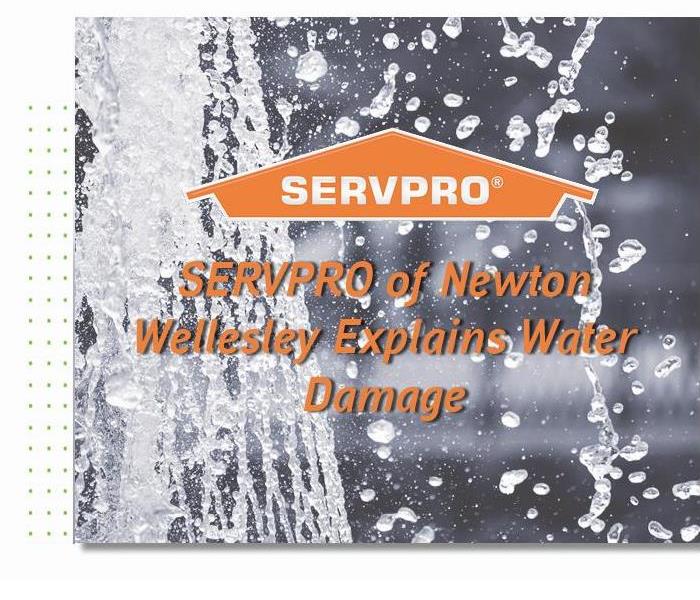 Leaking pipes and natural disasters can leave your home severely water damaged. If your property is affected, it is critical to identify the cause.
Leaking pipes and natural disasters can leave your home severely water damaged. If your property is affected, it is critical to identify the cause.
Leaking pipes, burst sewer lines, and natural disasters can leave your home severely water damaged. If your property is affected, it is critical to identify the cause and act quickly.
Water damage can be very stressful to deal with, especially because more problems can arise. Here is some information that might help you understand more about water damage.
- Water Volume: If your home is experiencing water, you can typically manage it on your own. However, if there is significant flooding that is not going away, it might be best to call a professional.
- If your neighborhood is recovering from a large flood, and your home has suffered significant damage, you should hire a professional to help with restoration.
- The first thing to do when you discover water damage in your home is to unplug all electronics. By using this equipment despite the situation could cause electrical shocks or even explosions.
- Mold can spread quickly once it infests an area, so it should be inspected for growth. Oftentimes, mold can appear inside the walls or floors, so it’s important that this inspection is ongoing.
- Before more damage occurs, eliminate moisture and dry out the affected areas. You can use fans or a large-capacity dehumidifier to circulate air and dry out the surrounding materials. This won’t prevent mold growth altogether, but properly drying out the area will help lessen the damage.
- If insulation or carpet, is soaked with water, you need to dispose of them immediately.
SERVPRO of Newton Wellesley is available 24/7 including holidays and weekends to assist you and help you with your water damage. “Like it never even happened.”
SERVPRO of Newton Wellesley Explains What to Do in the First 24 Hours After a Flood
5/10/2022 (Permalink)
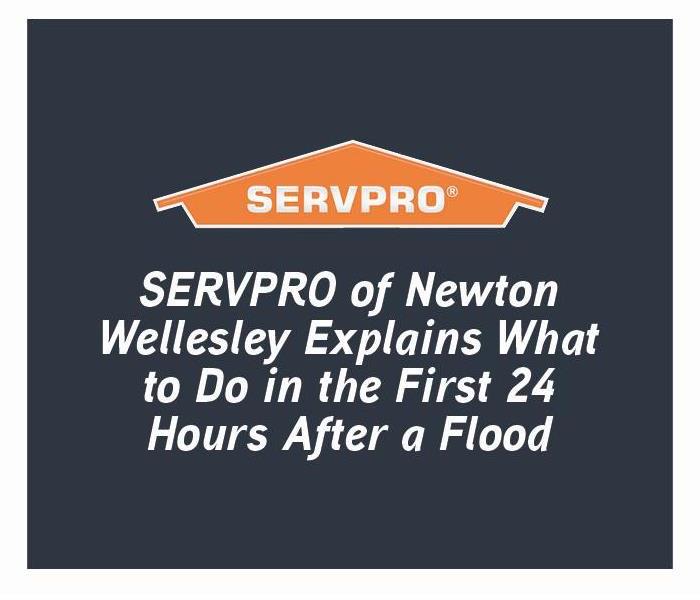 Floods in your building can be devastating; we know firsthand how overwhelming and stressful they can be.
Floods in your building can be devastating; we know firsthand how overwhelming and stressful they can be.
Floods in your building can be devastating; we know firsthand how overwhelming and stressful they can be. We have tips for you to do within the first 24 hours after a flood.
- Take Pictures: Before you remove any water, make sure to document the damage for your insurer by taking photos of the damage.
- Protect Your Health: The water could be contaminated by sewage or household chemicals. If you are staying near the flood make sure to wear rubber gloves.
- Call Your Insurance Company: Notify your insurer soon as possible after the flood. Keep your insurance company and local agent's phone number in your phone for times like these.
- Remove Water: Once you get the approval from your insurer to remove the water, use a sump pump and call a restoration company.
- Mitigate Mold Damage: Mold can happen within 24 to 48 hours of a flood. Make sure to remove wet contents, including carpeting and bedding quickly.
Flooding in your home or business requires professional help. Make sure to call your local restoration company to help get it restored as quickly as possible.
SERVPRO of Newton Wellesley is available 24/7 including holidays and weekends to assist you and help you with your damage. “Like it never even happened.”
SERVPRO of Newton Wellesley Shares Ways To Prevent Basement Flooding
4/9/2022 (Permalink)
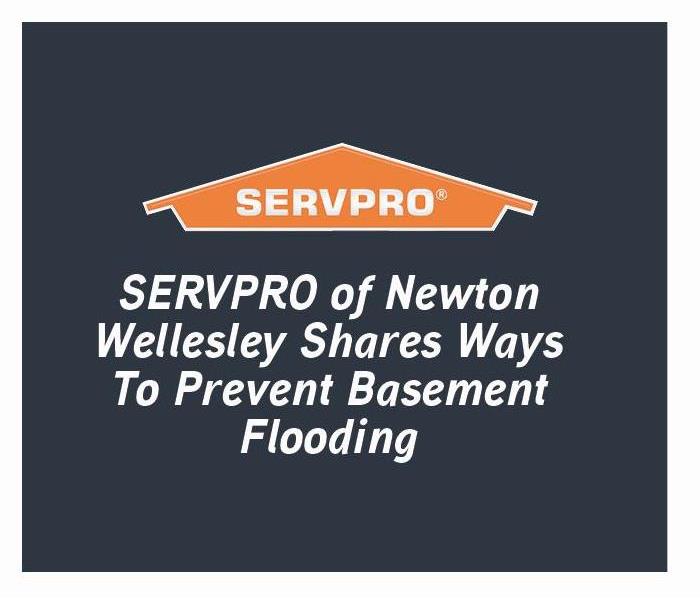 Springtime is a common time for storms and flooding to happen especially after a rainstorm
Springtime is a common time for storms and flooding to happen especially after a rainstorm
Springtime is a common time for storms and flooding to happen especially after a rainstorm. The most common floods happen in your basement; here’s how to prevent basement flooding:
- Leaves and sticks get trapped in gutters, it can block the passage of water. Ensure that you clear out debris from your gutters and downspouts.
- Water can get in easily when there are cracks in the foundation. You can fill cracks with a concrete patch.
- Sump pumps help to send water away from the home in basements. Make sure it is in good working condition.
- Install window well to help prevent melting snow and rain from entering your home.
- Bring in a skilled professional; A professional will be able to find vulnerabilities where water damage could occur.
SERVPRO of Newton Wellesley is available 24/7 including holidays and weekends to assist you and help you with storm damage. “Like it never even happened.”
SERVPRO of Newton Wellesley Helps Prepare for a Flood
4/5/2022 (Permalink)
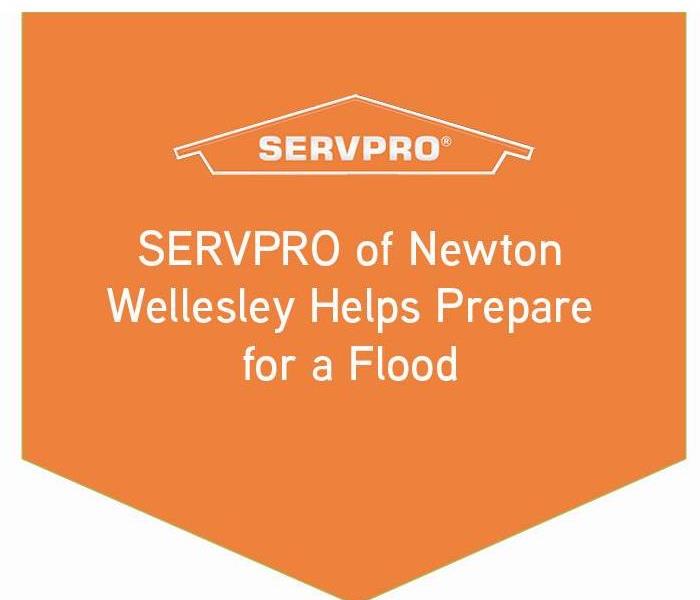 Here are a few ways to prepare for a flood.
Here are a few ways to prepare for a flood.
There are several ways to prepare for a flood, though it might not seem likely that you can fully prevent it. Here are a few ways to prepare for a flood:
- Visit FEMA's Flood Map Service Center to know the types of flood risk in your area. Also, make sure to sign up for your community’s warning system.
- Purchase or renew a flood insurance policy. It can take up to 30 days for a policy to go into effect so allow plenty of time.
- Make a plan for your household that includes what to do, where to go, and what you will need to protect yourselves from flooding. Make sure to be aware of evacuation routes.
- Keep important documents in a waterproof container. Protect your property by moving valuables to higher levels. Also, consider a sump pump with a battery.
SERVPRO of Newton Wellesley is available 24/7 including holidays and weekends to assist you and help you with water damage. “Like it never even happened.”
SERVPRO of Newton Wellesley Shares What To Do After A Flood
3/5/2022 (Permalink)
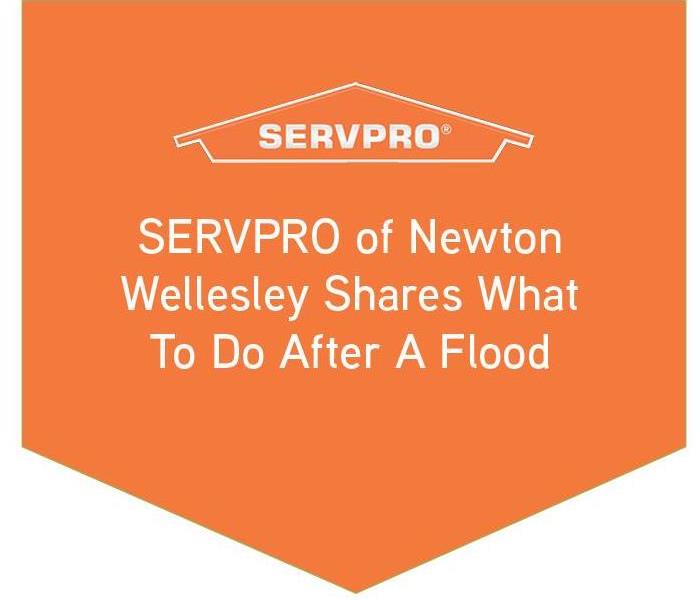 When a thunderstorm arrives it is common for a flash flood to occur.
When a thunderstorm arrives it is common for a flash flood to occur.
When a thunderstorm arrives it is common for a flash flood to occur. When the office fills with water it is understandable to think extraction first. However, the first priority should always be safety.
Here are some steps to take to ensure health and safety:
Reduce Additional Risks: Electricity can cause dangers with floods. If the power has gone out, and there’s standing water, you might be at risk for fire. Make sure to reach the fuse box and turn off the main power line.
Avoid Contact With The Water: Floodwaters may appear clean. However, they could be contaminated with bacteria, sewage, or household chemicals that can be harmful. If you must enter the damaged area, use proper protective gear.
Begin Cleanup & Mitigation: When storms damage your commercial property the best thing to do is to call water remediation experts.
SERVPRO of Newton Wellesley is available 24/7 including holidays and weekends to assist you and help you with water damage. “Like it never even happened.”
SERVPRO of Newton Wellesley Explains Actions to Take for a House Flood
3/5/2022 (Permalink)
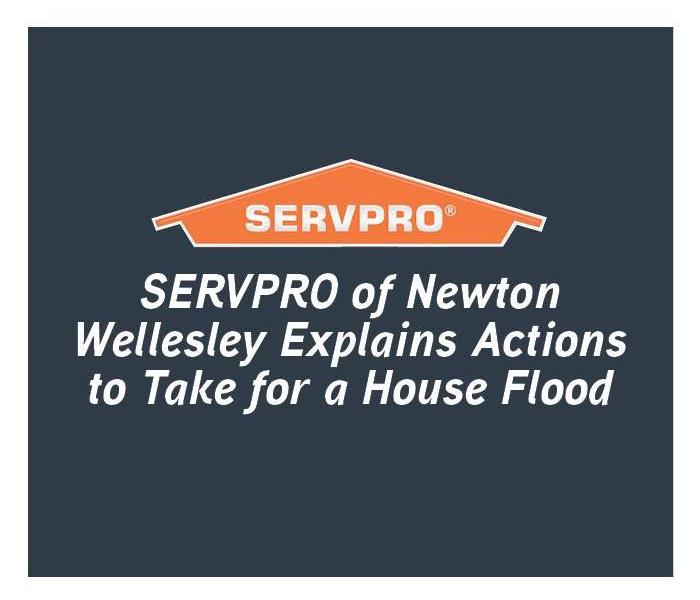 Floods are caused by a variety of things. Here are some practices to ensure the safety of you and your home should a flood arise
Floods are caused by a variety of things. Here are some practices to ensure the safety of you and your home should a flood arise
Floods are caused by a variety of things. Here are some practices to ensure the safety of you and your home should a flood arise:
Avoid Risks: If you have to evacuate, make sure it is safe before you return. Check for any warping, cracked foundations, or other structural damage.
Health: The water that is now in your home could be contaminated by sewage, so make sure that you wear waist-high waders.
Take Pictures: After a flood be sure to take photos or videos of your home to prove the damage to your insurance company.
Contact your insurance provider: Make sure you have your insurance company's information handy.
Clean-Up: This is where SERVPRO of Newton Wellesley can help. We will help remove water from your house and mitigate mold. This will ensure there is no long-lasting negative effect on you or your house.
SERVPRO of Newton Wellesley is available 24/7 including holidays and weekends to assist you and help you with water damage. “Like it never even happened.”
SERVPRO of Newton Wellesley Explains Ways to Protect Your Home From Flooding
2/3/2022 (Permalink)
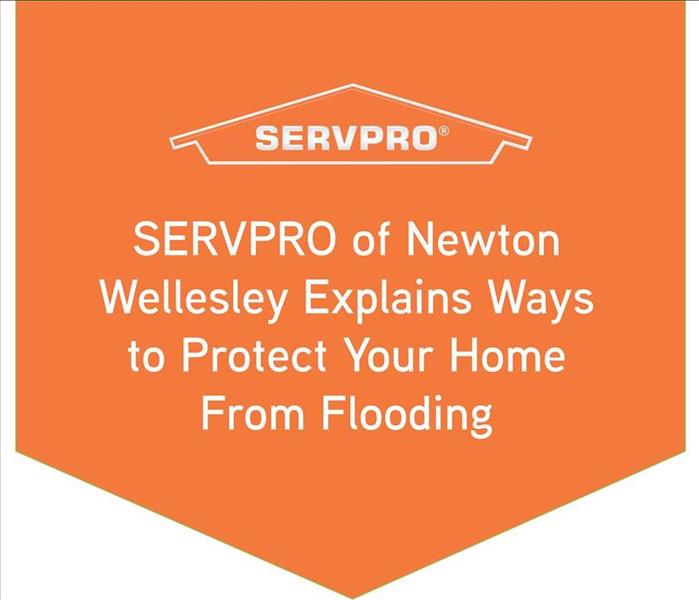 Flooding can happen anywhere at any time. It is hard to prevent flooding, but you can take precautions.
Flooding can happen anywhere at any time. It is hard to prevent flooding, but you can take precautions.
Flooding can happen anywhere at any time. It is hard to prevent flooding, but you can take precautions. It is important to know the flood level of your home first and foremost. Here are tips to help you:
- You will want to make sure to raise switches, sockets, circuit breakers, and wiring at least a foot above the expected flood level.
- Make sure Fuel tanks, air-conditioning units, and generators are anchored above your flood level.
- A flooded sewer system can cause sewage to back up. Make sure to install an interior or exterior backflow valve.
- Raise your home on piers or columns so the lowest floor is above flood level.
- Make sure to have clear gutters, drains, and downspouts.
SERVPRO of Newton Wellesley is available 24/7 including holidays and weekends to assist you and help you with your water damage. “Like it never even happened.”
Summer Awareness in Newton Wellesley
6/6/2021 (Permalink)
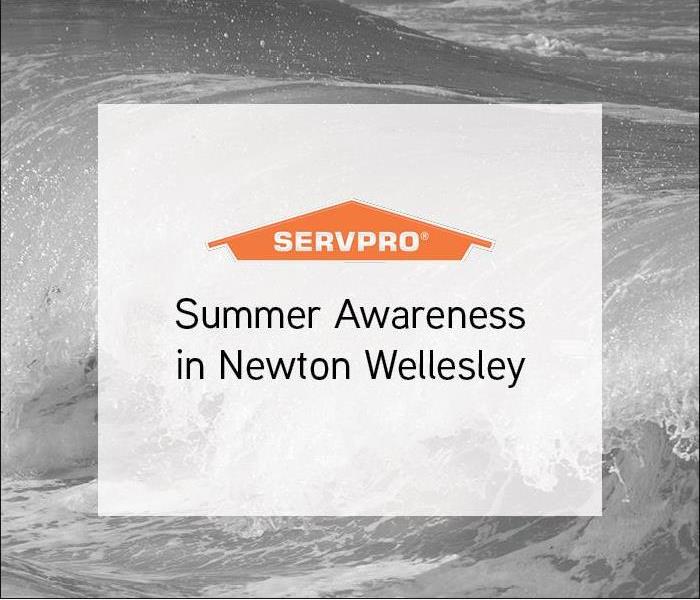 Did you know that June is the month for summer awareness? It seems like an easy no brainer idea. However, there is a lot to consider.
Did you know that June is the month for summer awareness? It seems like an easy no brainer idea. However, there is a lot to consider.
Did you know that June is the month for summer awareness? It seems like an easy no brainer idea. However, there is a lot to consider.
The National Weather Service (NWS) recognizes many safety hazards during the summertime including air quality, floods, heat, hurricanes, lightning, rip currents, tornadoes, and wildfires. Here are a few summer safety storm warning tips:
Watch the Clouds: A severe storm with the potential of developing deadly weather will often look very dark or even have a green tint.
Pay Attention to the Temperature: For severe storms and tornadoes to form, a mixture of warm, moist air at low levels has to collide with dry cold air above.
Sudden Wind Changes: Be prepared if it suddenly gets very windy or if there is an abrupt calm during or right after a thunderstorm.
Precipitation Changes: Be aware of hail or heavy rain followed by either calm or a fast, intense wind shift.
Listen Intently: If you hear a loud roar that is similar to a freight train, take shelter right away; a tornado has more than likely spawned.
Check the Radar: You don’t have to be a meteorologist to interpret the radar. When observing storms on the radar, look for large lines of red.
SERVPRO of Newton Wellesley is available 24/7 including holidays and weekends to assist you and get your home back to “Like it never even happened.”
Wet Carpets - Hidden Dangers
5/21/2021 (Permalink)
Excessive water spilled or leaking onto your carpet requires quick attention. It is not always as simple as letting the carpet dry on its own, even if the water is clean. Especially during the humid summer months, effectively extracting water may be more difficult in your Wellesley, MA commercial or residential property.
Water Removal first requires detection of and measurement moisture levels. SERVPRO of Newton/Wellesley technicians use moisture sensors with probes to penetrate through carpet and padding, reaching to the floor underneath to determine the presence of water. Moisture meters may also be necessary to determine the amount of moisture present.
Water Extraction
- Water extraction is key. The more passes made with extraction equipment, the better as it expedites the drying process.
- Self-propelled extraction equipment can be used throughout the impacted areas. The technician stands on them vacuuming up as much water as possible. Their body weight improves suction.
- The use of stationary extraction equipment is monitored regularly. The equipment is moved periodically to less dry areas, ensuring the best results.
- Air movement, ventilation, and dehumidification are all critical in effectively drying the carpet to prohibit mold colonies from forming.
- Air movers move warm, dry air over the impacted carpet while dehumidifiers pull moisture from the air.
Removing soaked carpet may be necessary, depending on the severity of the damage; however, our Disaster Remediation Teams have the tools and techniques to eliminate the need of removing water damaged carpeting in most cases.
Call the experts at SERVPRO of Newton/Wellesley - (617) 332-9000. We make it, "Like it never even happened."
Prepare for Flooding Season in Newton Wellesley, MA
4/26/2021 (Permalink)
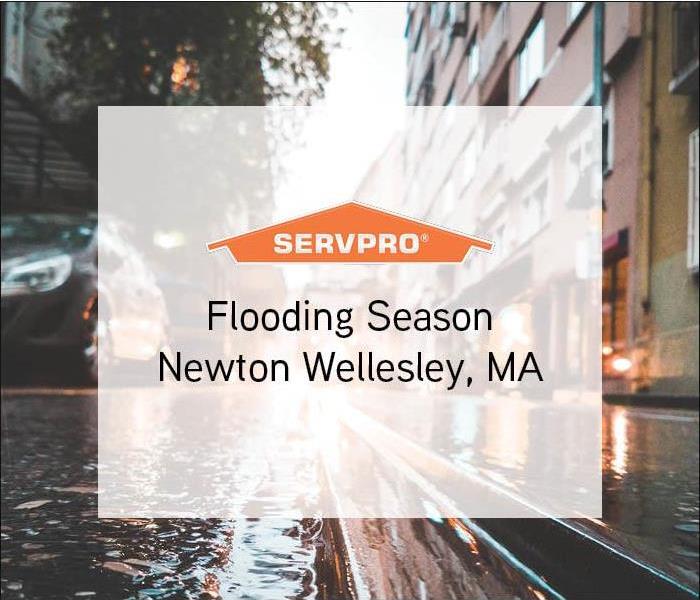 If you find yourself in need of water damage to your home or business, give SERVPRO Newton Wellesley, MA a call at (617) 332-9000
If you find yourself in need of water damage to your home or business, give SERVPRO Newton Wellesley, MA a call at (617) 332-9000
Flooding a topic that can be hard to prepare for. However, it is one of the most important topics that should not be overlooked. Flooding is a common hazard in Massachusetts. Some floods develop slowly. Flash floods can occur within minutes or hours after a storm it is best to not ignore flooding warnings.
There are so many different terms when it comes to flooding for you to be aware of.
- Flooding, flash flooding: Pay attention to changing flood conditions. You will want to be prepared to move to higher ground if needed.
- Flood Warning: This means that flooding is happening or maybe close by. You will want to avoid low-lying areas.
- Flash Flood Warning: A flash flood is occurring or might be happening soon. You should seek higher ground immediately.
There are plenty of safety tips you should take if flooding is happening in your area so you can be safe and prepared.
If you find yourself in need of water damage to your home or business, give SERVPRO Newton Wellesley, MA a call at (617) 332-9000, we respond faster to any size disaster.
What To Do After A Flood
4/6/2021 (Permalink)
When a thunder storm hits Wellesley, MA it is not uncommon, especially this time of the year, for a flash flood to occur. As the basement of your home or the showroom of your dealership fills with water it is understandable to think extraction first. Really, the first priority should always be safety. Regardless if you are a residential or commercial property owner, here are some steps to take to ensure the health and safety of you, your family and your customers.
Reduce Additional Risks
Electricity can cause additional dangers when your property floods. Even if the power has gone out, if there’s standing water, you might be at risk for electrocution or fire once the power is restored. If you can safely reach the fuse box and turn off the main power line, then do so. If not, call an electrician for help. They may need to disconnect your power externally. It may also be necessary call the gas and sewer companies as well to shut off those lines to prevent more damage.
Avoid Contact With The Water
Even if the floodwaters appear clean, they could be contaminated with bacteria, sewage, or household chemicals that can be harmful to your health. If you must enter the damaged area, use proper protective gear, including boots, hip waders, gloves, and masks. Take care when handling any items that have come in contact with the water, and throw away all food that got wet.
Begin Cleanup & Mitigation
When storms damage your commercial or residential property the best and safest course of action is to call water remediation experts. Heavy rains can cause major damage to Massachusetts properties. If yours suffers water damage from a storm, call the experts of SERVPRO of Newton/Wellesley at (617) 332-9000. Our one-stop, remediation to rebuild shop is ready to respond 24 hours a day, every day of the year, even holidays! We will make it, "Like it never even happened."
Removing All Water Damage
3/16/2021 (Permalink)
The Disaster Remediation Teams at SERVPRO of Newton/Wellesley are highly trained technicians who can troubleshoot and identify hidden water damage issues. No matter what type of water damage, remediation by untrained professionals, more often than not, is left incomplete. Although each situation is unique in terms of determining the outcome, there can easily arise oversight of minor issues such as moisture movement can influence the experience negatively. When SERVPRO of Newton/Wellesley responds to an incident at your Newton, MA commercial or residential property our responsibility is to ensure that the job is done correctly.
Moisture Movement Is Hard To Detect
Moisture movement can complicate water removal from any property. Sophisticated removal procedures or minimally evasive demolition is required to reach hidden areas of water and moisture. Such steps lead to higher costs or lengthen restoration periods. There are four main methods of moisture movement;
- Liquid flow
- Capillary suction
- Air movement
- Vapor diffusion
Apart from liquid flow, which you can readily see, the other processes are hard to notice without the use of advanced techniques or tools. As the moisture moves, it transfers damage from the areas initially affected. It also causes further deterioration of materials and if left unchecked, the result could be secondary damage the can range from mold infestation to structural damage.
When you first suspect water damage to your commercial or residential property, immediate resolution will save you time and money. The Disaster Remediation Teams at SERVPRO of Newton/Wellesley have a fast and thorough response that will help you identify the cause of your water loss. Call us at (617) 332-9000! We will make it, "Like it never even happened."
Water Remediation Experts
3/16/2021 (Permalink)
When water damage occurs in your Wellesley, MA commercial or residential property, calling in the professionals is the smart choice. Our Disaster Remediation Teams are able to quickly fix and correct any water damage. Commercial and residential property owners can rest assured, when SERVPRO of Newton/Wellesley is on the job, the result will exceed expectations!
Why Is Professional Help Necessary
SERVPRO of Newton/Wellesley uses commercial-grade equipment in all of our water loss jobs. We have more resources and professional grade options than anything available at a home improvement or renovation shop. Our certified technicians also follow a careful process that ensures we do not miss anything and provide a safe environment once again.
- Inspection and Assessment – Technicians and Project Managers examine the property to make certain they understand the damage extent and have the equipment needed for restoration.
- Water Removal & Extraction – We use pumps and smaller vacuum units to draw out the majority of the water.
- Drying the Structure – Technicians use air movers and dehumidifiers to lower humidity and draw moisture out of structural property like wall framing and drywall.
- Cleaning and Sanitizing – Specialists clean off any debris that may have been brought up by the water and deodorize restorable items.
Stopping Moisture Movement
Although understanding that moisture movement is happening is useful, stopping the process is not that easy. Our technicians use several approaches, including:
- Expediting water extraction to limit the liquid flow
- Running dehumidifiers to manage humidity, limiting moisture spread through air movement
- Making flood cuts or removing wet materials to curb capillary suction
We have different types of water removal equipment, which ease removal under different circumstances. For example, submersible pumps are perfect when the water pools deeper than 2 inches, while portable units help ease access to different sections of the property.
When you first suspect water damage to your commercial or residential property, calling in professional help will minimize cost and the risk of secondary damage. The Disaster Remediation Teams at SERVPRO of Newton/Wellesley are hear to help. Call us at (617) 332-9000! We will make it, "Like it never even happened."
Large Water Loss Experts
2/4/2021 (Permalink)
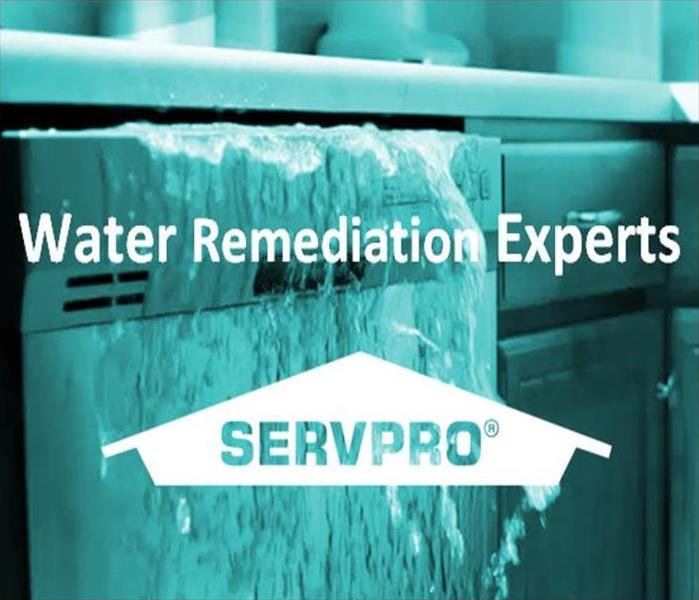
Typically New England Springtime is synonymous with flooding, not Fall. When water begins spreading across floors or filling basements, it is usually from a failed water heater shut-off valve or a split line on a washing machine. But as all residents of the Commonwealth know, our unpredictable weather can cause trouble without warning.
No matter where it came from, water removal for Hopkinton, Ma commercial and residential properties needs to be started, and finished, as soon as possible. It is why SERVPRO of Framingham technicians are on call 24 hours a day, every day of the year, including holidays! Our Water Damage Restoration Technicians can begin work within minutes after receiving a call.
If the water level is over two inches, each team of Restoration Technicians starts removal with a commercial grade, submersible pump. All water we remove goes directly in a drain, and not across the backyard to cause a problem for neighbors or the residents one street over. If possible, technicians direct it into sewer access if one is available.
For water levels under two inches, our teams utilize extraction wands and other, smaller devices. Each one has three components, but technicians start by using only the pump option to draw water off of floors. Once they begin drawing water out of carpets, upholstery, and other items, they use the other two, a heater and vacuum to carefully draw water out of carpets and from between floorboards.
That is particularly important for carpets. After they become soaked, the glue holding the layers together weakens significantly, and delamination, or separation of the layers, can occur. Our certified technicians know to carefully monitor all three components to prevent tearing carpets apart, as well as overheating the already damaged wood floorboards, cracking and splintering them. They will then lift the carpets, remove the carpet pad, and dry the floor using air movers and fans to force warm air over and under the carpet while also drawing out the damp air and sending it outside the nearest window or another exit. Once completed, they insert a new pad and then stretch the carpet back in place.
If you experience a sewage backup the first step, if it is safe to do so, is to turn off the Water Main. Then call the water remediation experts of SERVPRO of Newton/Wellesley to remediate the water damage. and to determine the cause of the burst pipe at (617) 332-9000. We will make it, "Like it never even happened."
Why Hire Water Remediation Professionals
6/26/2020 (Permalink)
The Disaster Remediation Teams at SERVPRO of Newton Wellesley are certified water restoration experts and use tools and techniques scientifically proven to help. Knowing who is responsible for what aspect of restoration and recovery in your home after a loss incident can be stressful and overwhelming. Our technicians can make it easy by offering a comprehensive approach encompassing nearly every phase of restoration and later build back necessary.
Even basics like water cleanup for Hopkinton, MA commercial and residential properties can indicate different tasks that professionals like ours need to complete. We can work with your insurance provider to offer you a fast and reliable service that follows the boundaries of your coverage and limits any out-of-pocket expenses for you.
Your property needs to get thoroughly dried after a loss incident, and this can have a direct effect on the speed and final product of cleaning processes. We have professional grade, state-of-the-art equipment that can begin drying out damaged areas of your house quickly. With units like high-velocity air movers and desiccant dehumidifiers, we can provide customers with effective drying solutions that can return their property to its original condition sooner than expected.
Many property owners consider cutting out the middleman when it comes to restoring their houses, but there are potential pitfalls to this approach. Not only can DIY cleanup be ineffective when the full spectrum of moisture damage does not get addressed, but without the appropriate potent products and technologies for cleaning, your property might not only look like it used to, but also, may not be properly remediated, increasing the possibility of mold growth. We offer:
- Professional and efficient service
- EPA approved, commercial grade cleaning products
- Thorough results
Cleaning up after a water loss can be a necessary step in making disasters “Like it never even happened.” Call the experts at SERVPRO of Newton Wellesley today, (617) 332-9000!
The Need For Speed
5/27/2020 (Permalink)
Often in New England you will hear someone say, “Can’t control Mother Nature.” While that may be true it is possible to help her. If your Needham, MA commercial or residential property suffers water damage the drying process can be expedited. The amount of damage your property suffers is directly related to the speed in which the structure and its contents are properly dried.
But what if you could speed up the process of drying when your home or business suffers an unfortunate event such as water damage from putting out a fire or burst water pipe. Did you know there is an actual science behind the process of drying? Before reaching for the towels, a mop, or perhaps a fan ask yourself, what do I know about Psychometrics?
Psychometrics is essential to restoring a water damaged structure to its preloss condition. The Disaster Remediation Teams at SERVPRO of Newton/Wellesley are trained in this science of drying and follow strict industry approved standards to help lower the chances of secondary damages. We will:
- Inspect the building to detect every component that is wet to help prevent secondary damage from happening.
- Measure how much moisture is in wet materials and monitor whether the materials are drying properly.
- Speed up Mother Nature by using professional drying equipment.
A wet building can often dry naturally because the environment always seeks equilibrium. When materials are wet, moisture will naturally move to drier air at the surface of the material, but only if the air is drier. The issue, nature often takes too long resulting in secondary damage to the structure of your property and its contents. Out certified technicians have the training and equipment to dry tough to reach places, hardwood floors, inside walls, and so much more. Using state of the art monitoring equipment and a proven scientific process they will expedite the drying process and mitigate the risk of secondary (mold) damage.
When your commercial or residential property suffers fire damage call SERVPRO of Newton/Wellesley at (617) 332-9000. We will make it, "Like it never even happened."
Pipe Bursts Keeps SERVPRO of Newton/Wellesley & Framingham Crews Busy
2/20/2018 (Permalink)
Originally posted in the Metro West Daily News:
As temperatures in MetroWest plummeted to minus-12 degrees Sunday, business for David Kurzontkowski started heating up.
Kurzontkowski, owner of SERVPRO Framingham, said the extreme cold over the weekend caused sprinkler heads to pop and pipes to burst in homes and commercial buildings. Kurzontkowski, whose crews go in to clean up damage after emergencies, said his phone started ringing at 9 a.m. Sunday “and then it just hasn’t stopped since.”
“I’m just driving from burst pipe to burst pipe,” he said Monday.
And now, as it gets warmer, there’s still a high risk: He expects more water pipes that froze from the cold will burst as they start to thaw out.
“I think it’s going to get a little worse before it gets better,” Kurzontkowski said.
Plumbers, firefighters and cleanup crews across the region kept busy dealing with heat problems and burst pipes and don’t expect it to slow down for days.
Proper Water Damage Restoration
3/28/2017 (Permalink)
Even small water damages have the potential to cause serious structural and indoor air quality issues over time. The key to avoiding costly future restoration is to handle every water problem as a real threat to your property.
Don’t treat flood water in unwanted places lightly: even if your basement only has an inch of water in it, or is even just damp, it is the perfect breeding ground for mold. Mold growth not only ruins walls, furniture, carpets, flooring to name a few. Mold can lead to poor indoor air quality causing respiratory problems including asthma, and can lead to severe illness. Preventing mold growth is key to keeping your home’s air clean and healthy.
SERVPRO Framingham and SERVPRO Newton/Wellesley specialize in restoring contents damaged by fire, water, or mold. Their expertise and “restore” versus “replace” mentality can help you save money while preserving precious keepsakes that can’t be replaced. They pretest your contents to determine what items can be restored back to their condition before the water damage. SERVPRO Professionals utilize several methods of cleaning your contents, including:
- Dry Cleaning - Used for cleaning light residues or to pre-clean prior to wet cleaning.
- Wet Cleaning - An effective cleaning method for removing moderate to heavy residues.
- Spray and Wipe -Effective for items that can’t withstand wet cleaning.
- Foam Cleaning - Used for upholstery fabrics that might shrink or bleed if wet cleaned.
- Abrasive Cleaning - Involves agitation of the surface being cleaned.
- Immersion Cleaning - Contents are dipped into a bath of the cleaning product.
SERVPRO Framingham and SERVPRO Newton/Wellesley provides emergency cleaning and restoration services 24 hours a day, 7 days a week—including all holidays. You can expect an immediate response time, day or night.
Why chose an IICRC firm like SERVPRO of Newton/Wellesley?
6/27/2016 (Permalink)
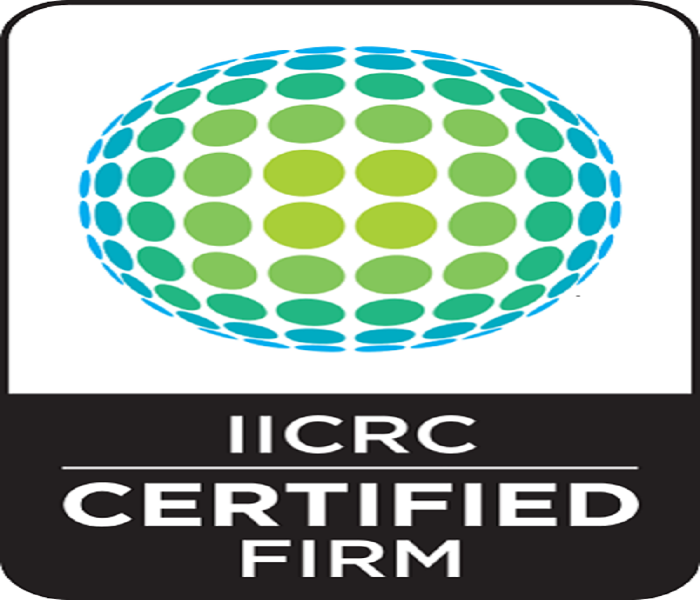 SERVPRO of Newton/Wellesley is an IICRC firm giving you the confidence that the right people make it "Like it never even happened".
SERVPRO of Newton/Wellesley is an IICRC firm giving you the confidence that the right people make it "Like it never even happened".
Always Look for the IICRC logo
IICRC Certified Firms have earned the right to display the IICRC logo as a symbol of quality. In order to achieve IICRC-certified status, firms must meet a rigorous list of standards in business ethics and expertise. All IICRC Certified Firms must:
- Present accurate information to consumers and conduct business with honesty and integrity.
- Require a technician on all jobs who has been formally trained and passed all required tests.
- Require a continuing education program to keep technicians up-to-date on the latest changes in the industry.
- Maintain liability insurance to protect all parties in the event of an accident.
- Maintain a written complaint policy and agree to Better Business Bureau or similar arbitration to resolve disputes, and accept the conclusions and recommendations of arbitration.
When it comes to cleaning, restoration and inspection, the IICRC writes the books
As an ANSI-accredited Standards Developing Organization (SDO), the IICRC has led the way in establishing the main industry standards and reference guides for professional carpet cleaning, upholstery and fabric cleaning, water damage restoration and mold remediation.
Each IICRC standard takes years to develop and the coordination of several experts in the field, including allied tradespersons; manufacturers; international, national and regional trade associations; individual or franchise professionals; cleaning, inspection and restoration industry organizations; insurance industry; training schools; contractors; and public health professionals.
These standards are reviewed and updated at least every five years. Many of these fields, such as the water damage restoration field, change rapidly and those who are certified keep up with the advancement of the science and generally accepted practices of the industry.
The IICRC helps keep homes and businesses healthful
According to the Environmental Protection Agency, the average person spends 90 percent or more of their time indoors, where levels of pollutants may be two to five times (and occasionally more than 100 times) higher than outdoor levels.
This makes it extremely important to perform regular maintenance inside your home or business. In addition to vacuuming, cleaning and checking for water damage on a regular basis, using a certified technician for cleaning will help extend the life of your flooring and upholstery and ensure that your home or business is healthful for those who live and work there.
SERVPRO of Newton/Wellesley is here to help with all your restoration needs, please contact our office at (617) 332-9000.
Water Damage Tip for Property Owners
1/7/2016 (Permalink)
Water Damage Response Tips for Home Owners
(These tips are for Category 1 water situations ONLY, which is water that originates from a sanitary source and poses no substantial risk from dermal, ingestion, or inhalation exposure.)
- Shut off the source of water if possible or contact a qualified party to stop the water source.
- Turn off circuit breakers for wet areas of the home/building, when access to the power panel is safe from electrical shock.
- Remove excess water by mopping or blotting.
- Wipe excess water from wood furniture after removing lamps and tabletop items.
- Remove Oriental or other colored rugs from wet carpeting.
- Do not use a regular vacuum to remove water.
- Do not turn on ceiling fixtures if ceiling is wet, and keep out of areas where ceilings are sagging from retained water.
- Do not leave books, magazines, or other colored items on wet carpeting.
Even small water damages have the potential to cause serious structural and indoor air quality issues over time. The key to avoiding costly future restoration is to handle every water problem as a real threat to your property. If you have any questions or need help to ensure your property is drying properly, call SERVPRO of Newton-Wellesley (617) 332-9000.
 As a trusted leader in the restoration industry, SERVPRO of Newton/Wellesley is equipped with the advanced training and tools needed to restore.
As a trusted leader in the restoration industry, SERVPRO of Newton/Wellesley is equipped with the advanced training and tools needed to restore.






 24/7 Emergency Service
24/7 Emergency Service






























